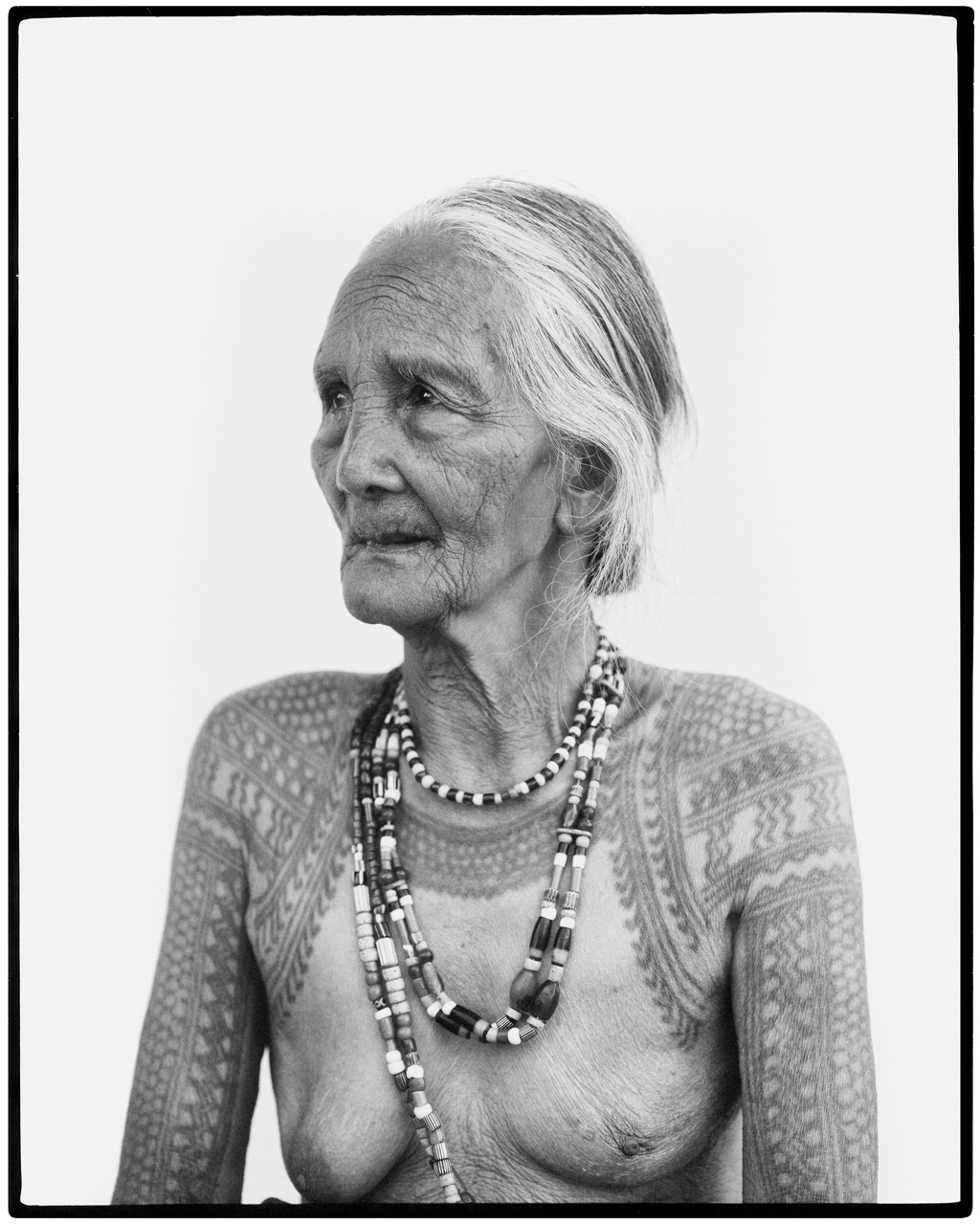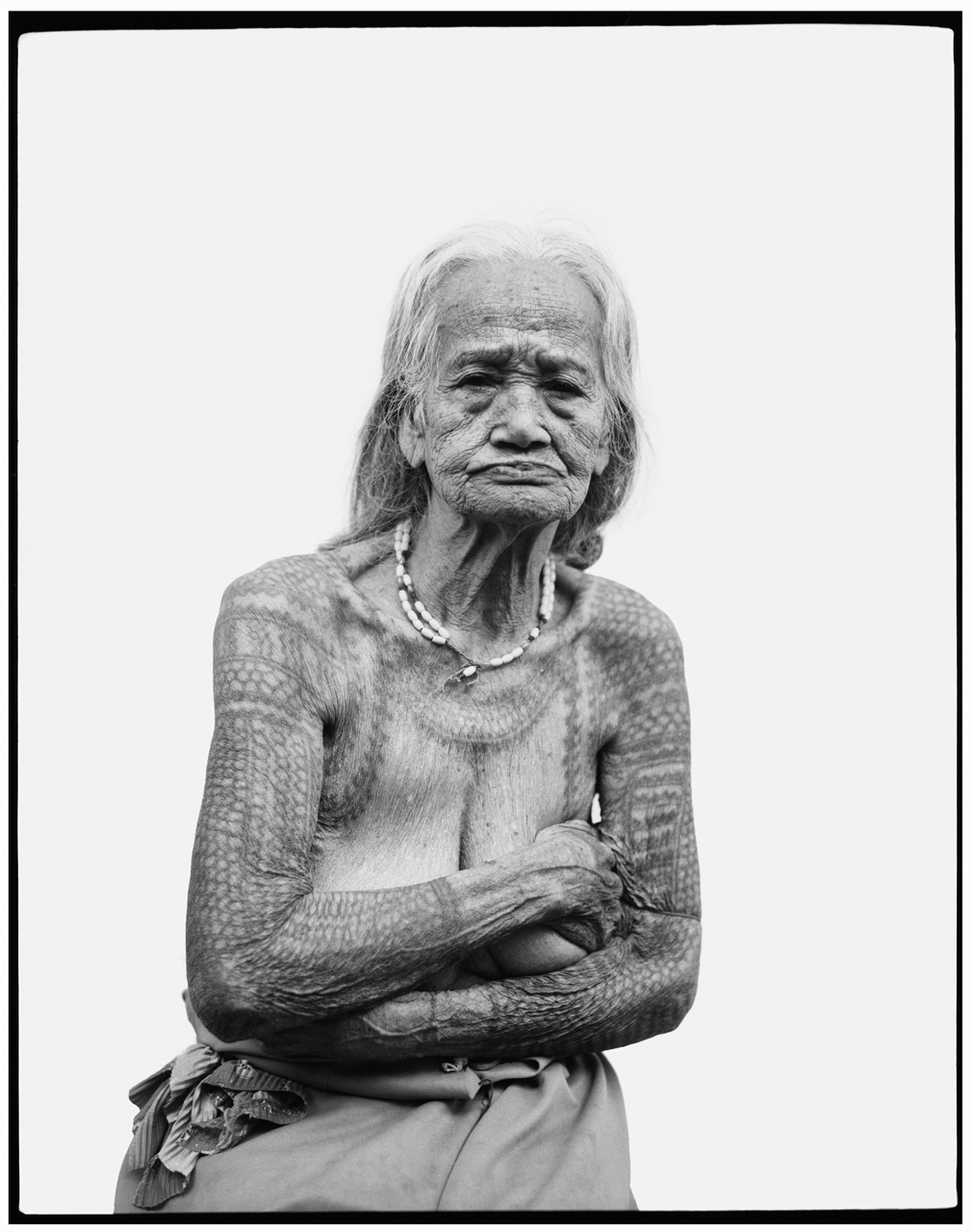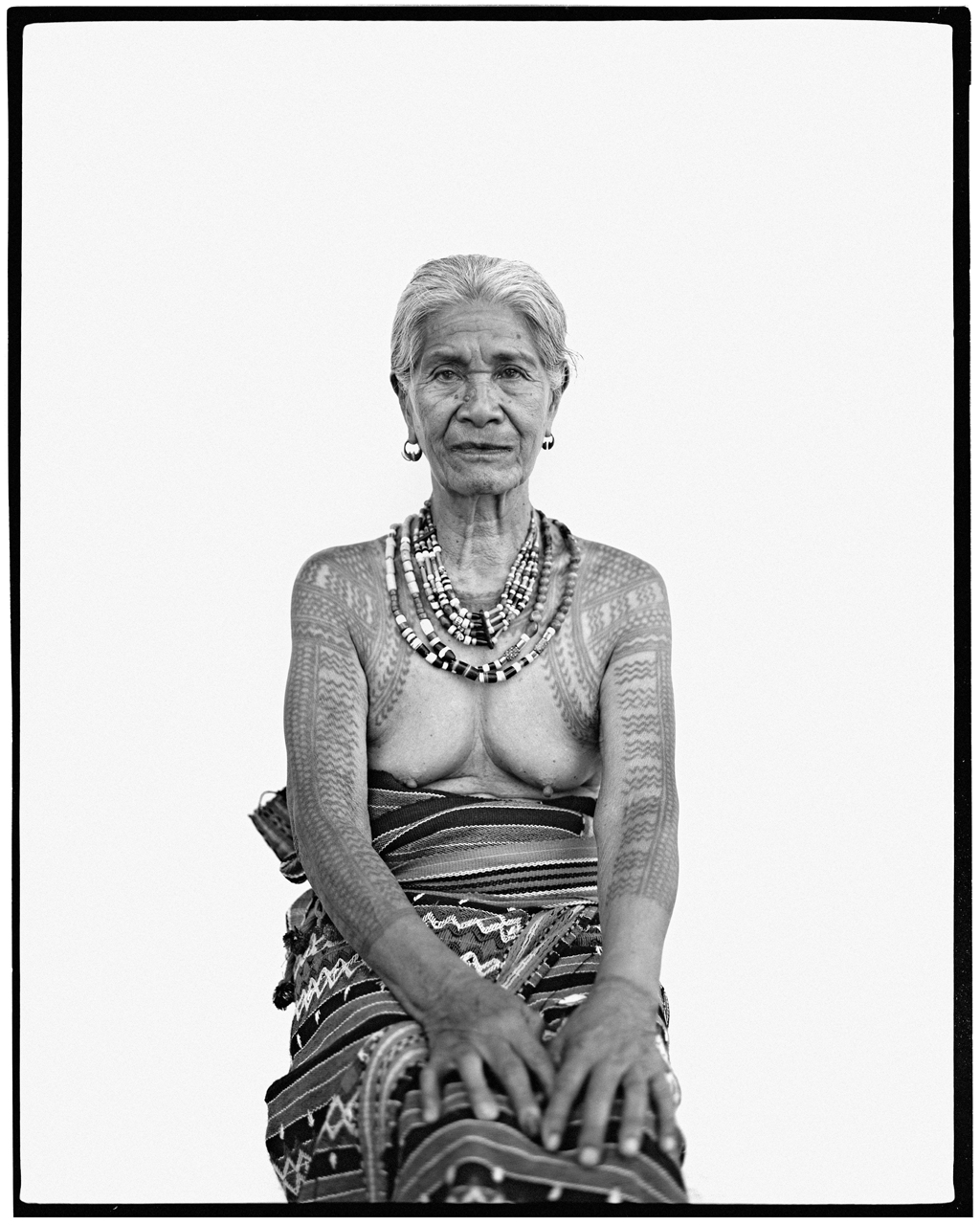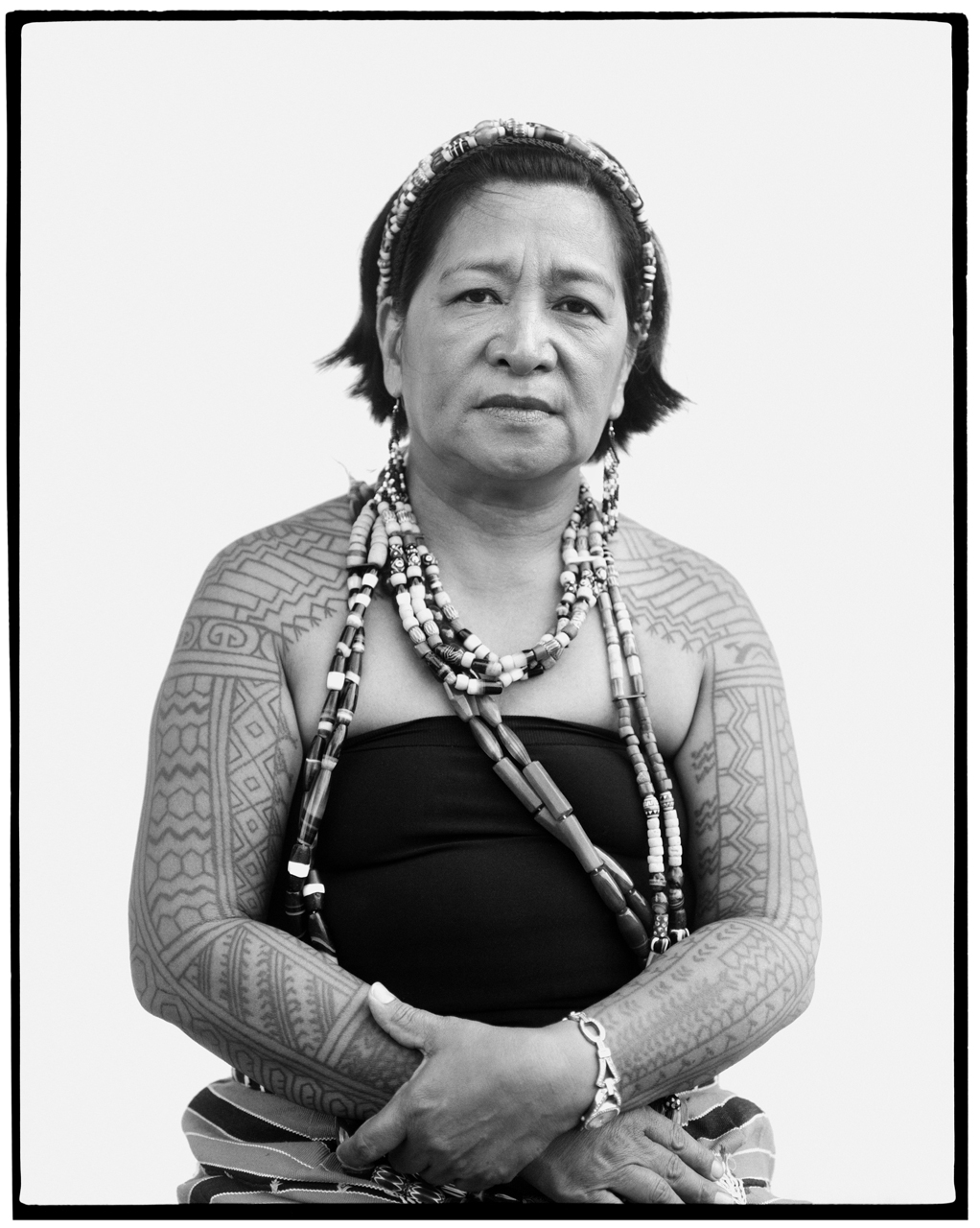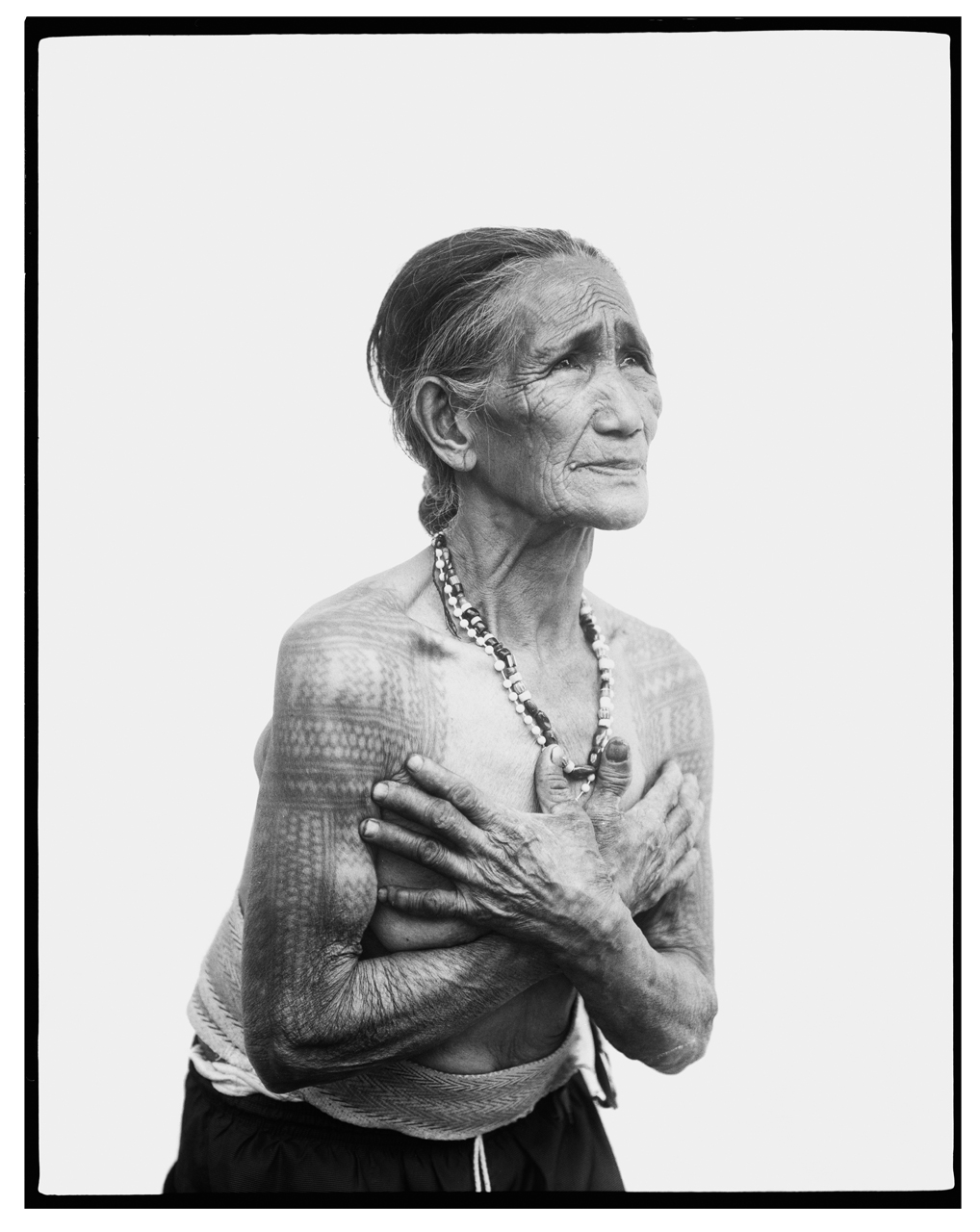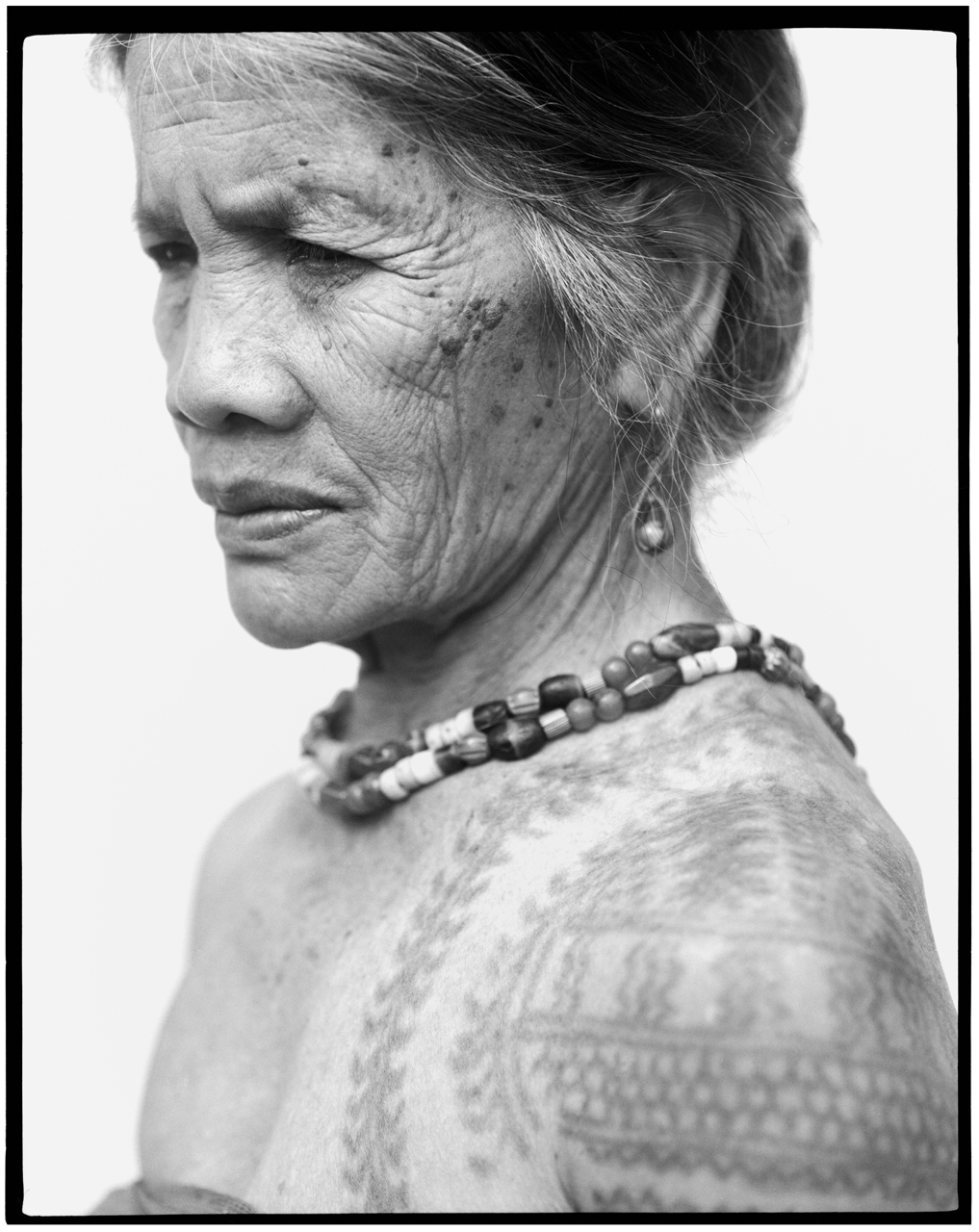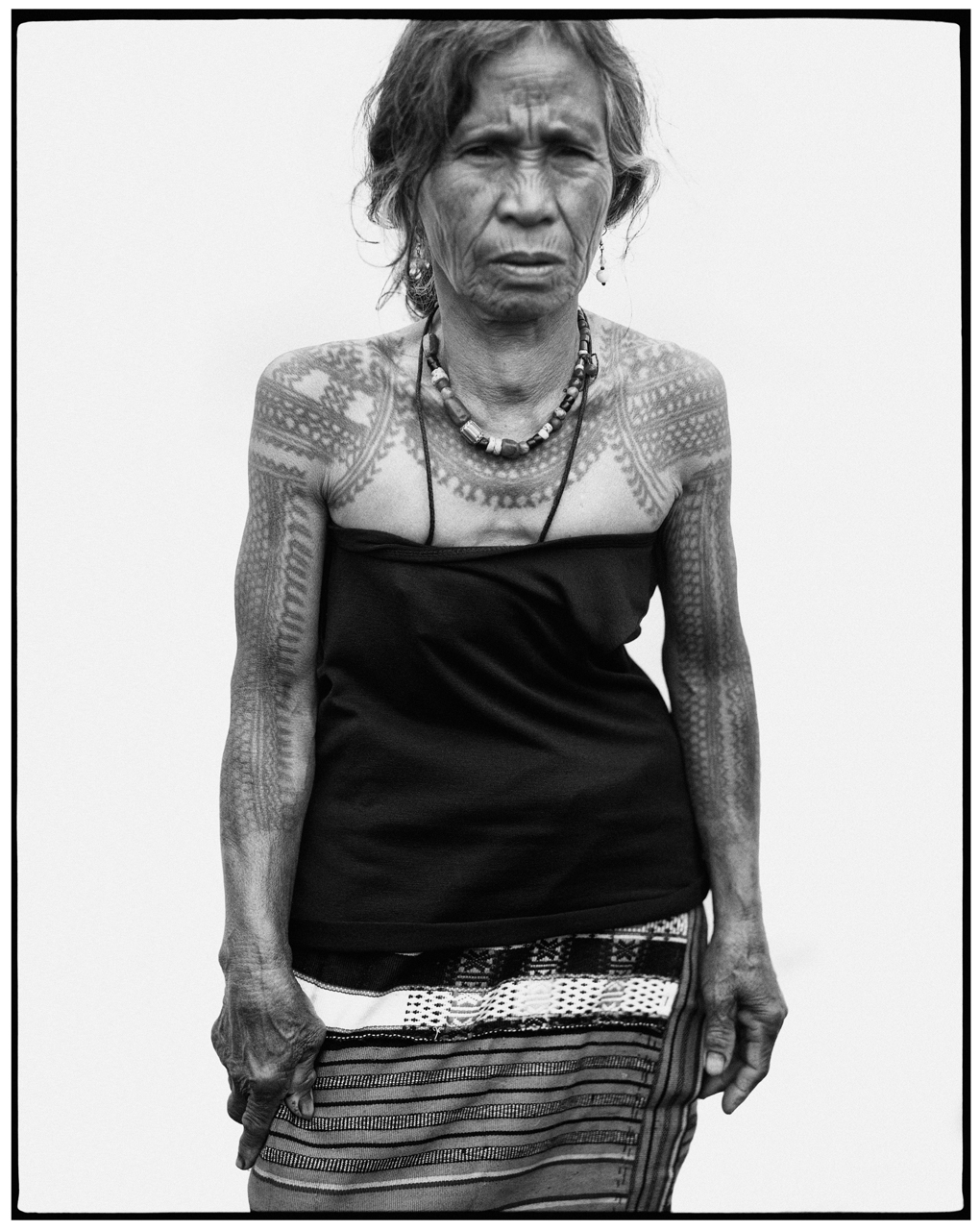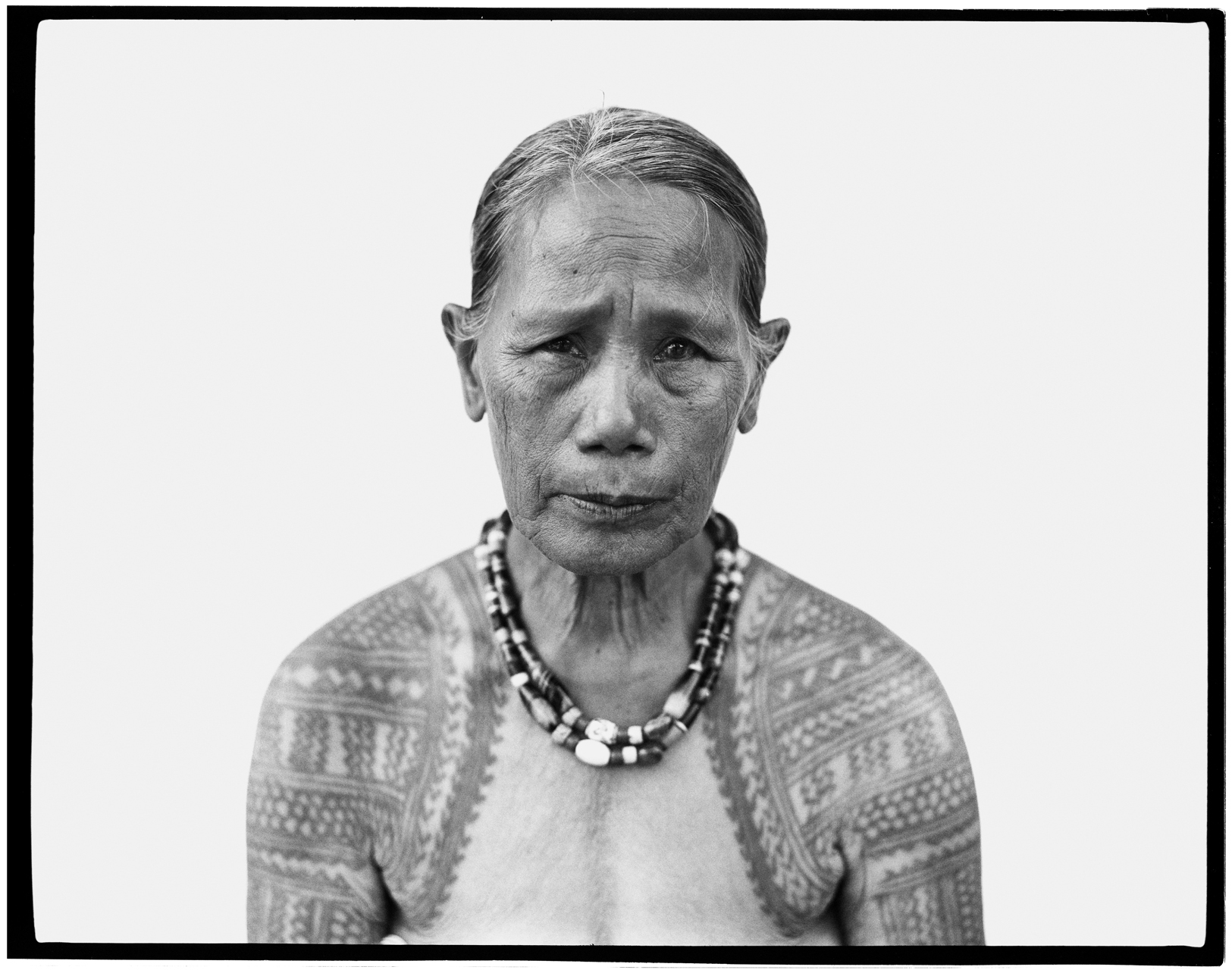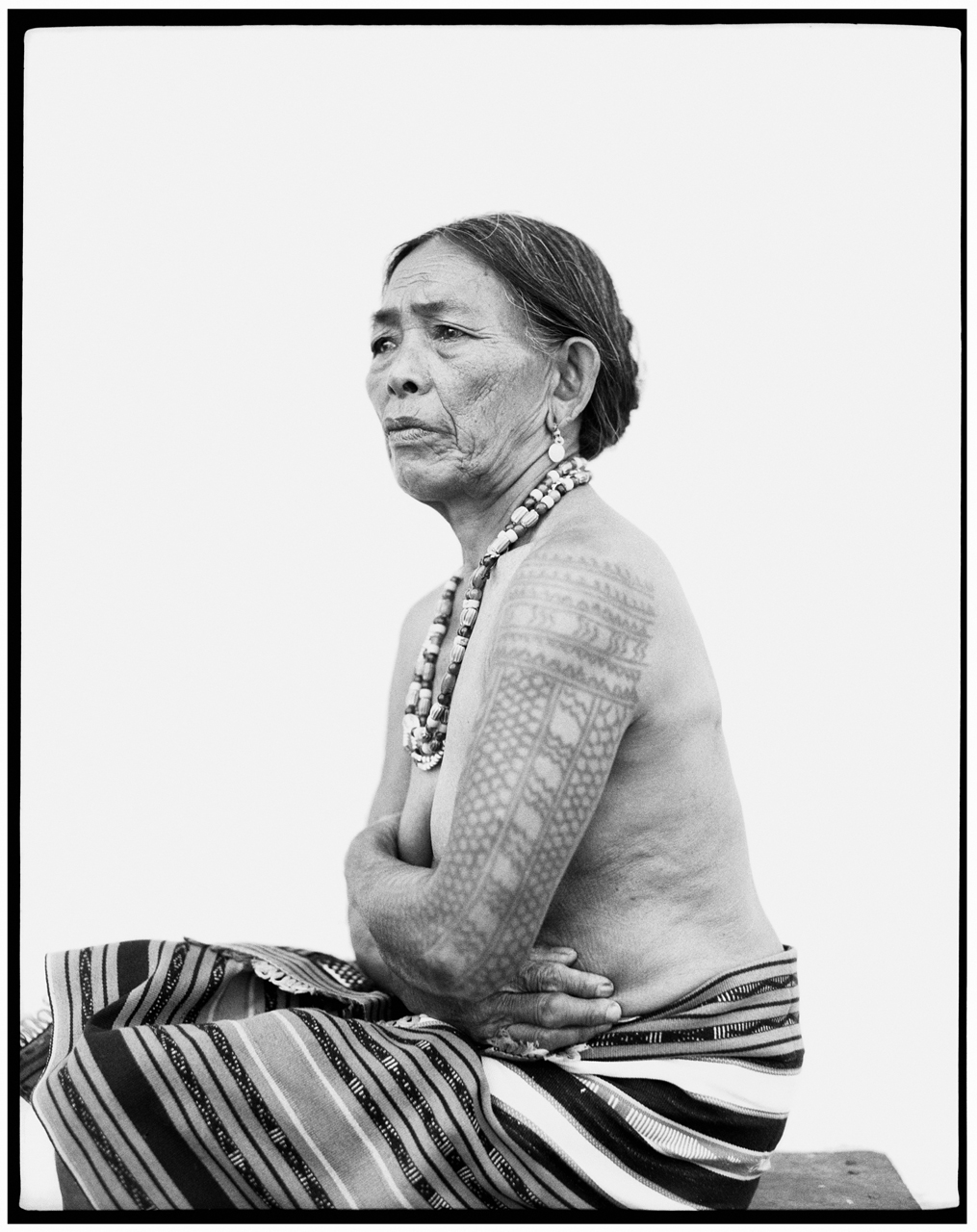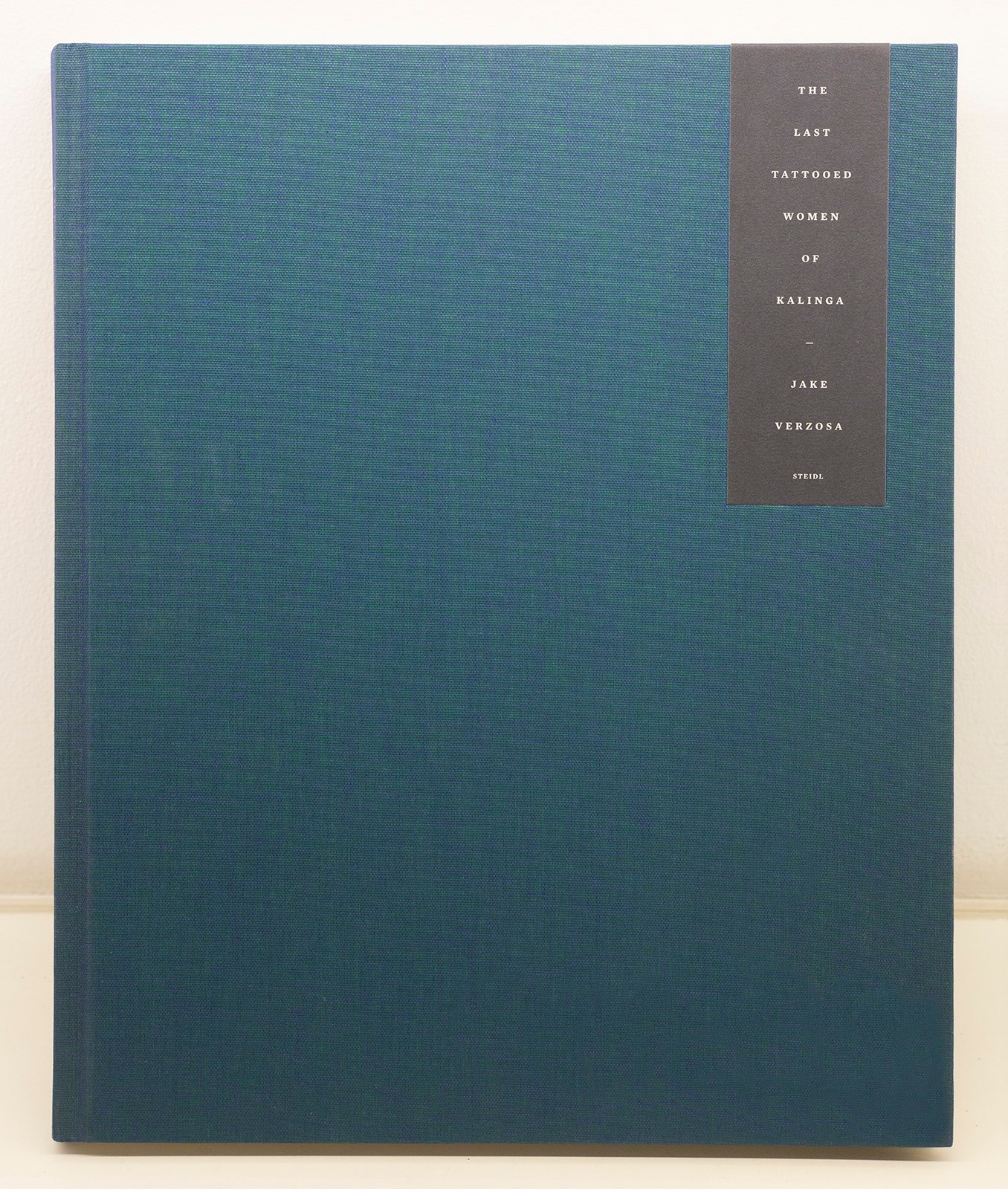
According to the photographer Jake Verzosa (b.1979, Tuguegarao, Philippines), the sight of the tattooed women of Kalinga used to scare him as a child. Growing up in the rural capital of the Cagayan Valley Region, visited frequently by townsfolk and tribes from neighboring Kalinga to trade goods and acquire supplies, Verzosa would hear stories about them as headhunters, that they’re involved in some such vocation sure to give gullible minds a good fright. Who would have thought then that decades after, Verzosa would become their unofficial ambassador, introducing their culture to the world, creating an understanding of their distinguishing marks through his photographs?
The journey to Verzosa’s “The Last Tattooed Women of Kalinga” began for the photographer as curiosity and an artist’s inherent craving to create something connected to his place of origin. And so chancing upon a break from commercial work in 2009, Verzosa organized a trip on his own and found Natividad Sugguiyao, provincial officer of the National Commission for Indigenous Peoples in Kalinga. She would become his co-author for the book on the tattooed women—and one of his subjects for the photographs, Sugguiyao being a tattooed woman herself—but first of all she would be his indispensable companion in the province, leading him to the villages and ushering him to the women’s homes, introducing the photographer to his subjects, some of whom have not faced a camera before, informing them of their mission: to document the last of their kind.
Verzosa encountered no hesitation from the women, even if they had to take their tops off for his pictures. It must have been a while since they last displayed their markings to an audience, these beautiful patterns tapped onto their flesh, once badges of beauty, strength and character —before the generation that came after them started finding tattooed women strange, ridiculous and dirty, thanks to Western ideas of beauty that influenced younger members of their tribe.
Verzosa encountered no hesitation from the women, even if they had to take their tops off for his pictures. It must have been a while since they last displayed their markings to an audience, these beautiful patterns tapped onto their flesh, once badges of beauty, strength and character —before the generation that came after them started finding tattooed women strange, ridiculous and dirty, thanks to Western ideas of beauty that influenced younger members of their tribe.
In the villages, Verzosa would enter each house armed with his film camera, a tripod, and a white backdrop rolled up in his backpack. The decision to shoot with film doubtless benefited the portraits. It dictated that the shooting process proceed like a ritual, with the time needed to setup each sitting allowing for the women to ask their questions—What is this gadget? Why are you taking our pictures?— and for Verzosa to answer, creating an uncontrived connection between lensman and subject. (There was a language barrier, yes, but Sugguiyao would serve as bridge.)
Unlike in other shoots where the digital camera would give Verzosa the freedom to click away as much as he wanted, this one needed to be more formal, each pose more intentional, the fall of a hand or the angle of the head arranged just so—the better to keep the photographer to his limit of 12 shots per subject. The portraits show the women in varying expressions: amused by the contraption in front of them, pensive, sad, proud, tired, uneasy with exposing their breasts, happy. And then there’s something else the film captured. “The women’s stares,” says Verzosa, “you can’t get that from a digital camera or anything instant.”
Verzosa worked on the project on and off for three years. On each trip, he would stay with a family from the village, delay shooting for a week in order to immerse himself with his surroundings, and then spend the next week or three shooting the portraits. Each time he would return from Manila, he would take with him prints of the portraits to give to the women. This was initially the only projected end to Verzosa’s endeavor—to document the last tattooed women of Kalinga, and award them a copy of their likenesses.
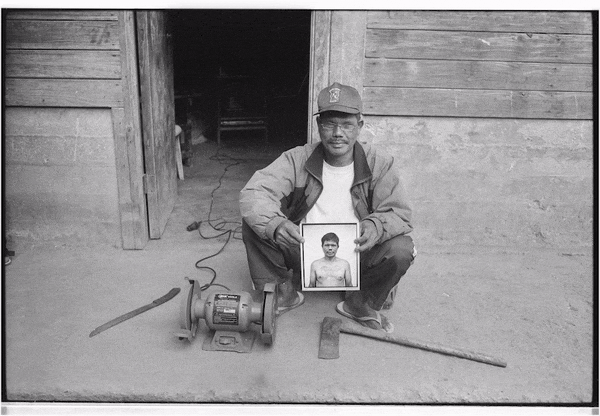

Verzosa worked on the project on and off for three years. On each trip, he would stay with a family from the village, delay shooting for a week in order to immerse himself with his surroundings, and then spend the next week or three shooting the portraits. Each time he would return from Manila, he would take with him prints of the portraits to give to the women. This was initially the only projected end to Verzosa’s endeavor—to document the last tattooed women of Kalinga, and award them a copy of their likenesses.
But the images will travel far and wide, in book pages and framed photographs, apart from ending up in private collections. They’ve been published in book form twice: the first co-published by Silverlens Gallery in the Philippines, and the second with Gerhard Steidl in Germany, following the project’s win at the Steidl Book Awards in Singapore in 2016. This second edition was launched at the influential Paris Photo, the annual international art fair devoted to photography.
In the past decade, the collection have traveled to many festivals and exhibitions, in Amsterdam, Denmark, Paris, Nepal, Chicago, Gwangju, and Dali, China, apart from being honored with a special show at Silverlens Gallery in Manila in 2015.
Just as the photographs were spreading its wings and landing in different institutions abroad, there also was a growing interest in tattooing in different parts of the world. An important exhibition at the at the Musee du Quai Branly in Paris in 2014, called Tatoueurs, Tatoues, included Verzosa’s pictures of the Kalinga women. The show presented images of inked bodies from different cultures around the globe, exploring “the artistic nature of the practice” of tattooing, with Verzosa’s pictures likely serving to illustrate one of its early incarnations. The exhibition traveled to Ontario, Seoul and Los Angeles, exposing more eyes and nationalities to the Kalinga women, their unique markings and the culture they represented. “It also gave a face to our history when it came to tattoos, alongside others in the world,” says Verzosa.
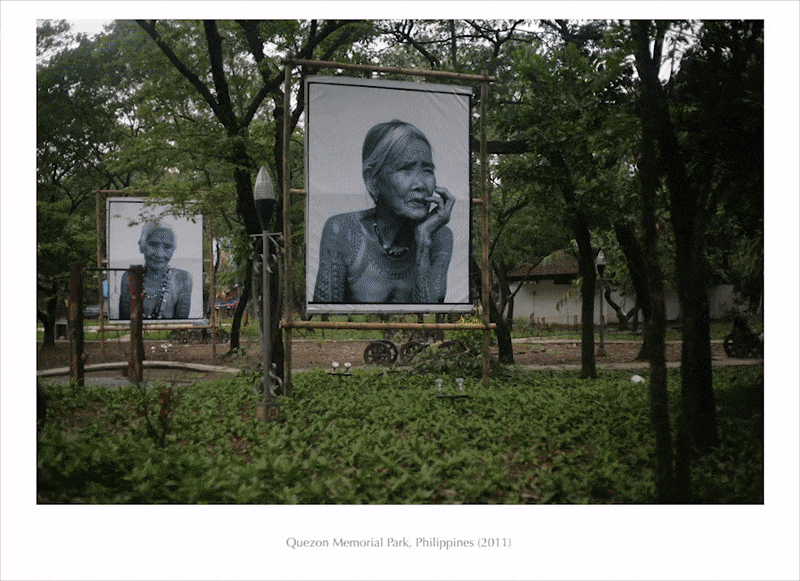
Meanwhile in the Philippines, local and foreign tourists were making a pilgrimage to the thatched roof village of Buscalan to seek the services of Kalinga’s oldest mambabatok, or tattoo artist, Fang-Od. The lady has found herself a sensation at nearly 100 years old, with fans lining up for hours just to get inked by her in the traditional Kalinga way. What was a dying art when Verzosa began his project was all of a sudden so popular—no small thanks to the power of social media. Fang-Od, one of the women in Verzosa’s portraits, already had by this time passed on the skill she learned at 15 from a Kalinga warrior to her grandniece.
In 2017, the famed mambabatok’s presence at the furniture and design fair, Manila FAME—she was flown in by the Philippine Air Force for the event—led to accusations that the organizers were exploiting the tattoo artist after a photo of what seemed like an exhausted Fang-Od went viral online. It turns out Fang-Od did agree to the two-day live tattooing including a speaking engagement. The ruckus would, however, spark a discussion about the commodification of culture and the use of indigenous peoples for business interests. Later on, in 2018, Fang-Od would be given the Dangal ng Haraya award from the National Commission for Culture and the Arts for her unique and lasting contribution to Philippine Arts and Culture.
Most recently, an ethnographic film called “The Modern Mambabatok” is being screened in different places in the US. Directed by Kayla Sotomil, an ethnographic filmmaker, it “explores the modern practice of Filipino hand tap tattooing” through the eyes of Lane Wilcken, who calls himself a cultural tattoo practitioner, and whose mother is from the Philippines. The difference about Wilcken’s practice, however, is that it seeks to decolonize the practice, stripping the procedure of the rituals and spirituality attached to it and putting the focus on the art.
More than 10 years after he started taking its first pictures, “The Last Tattooed Women of Kalinga” has become the body of work most associated with Verzosa. Through its sheer popularity and the extensive journeys it’s been through, this collection will doubtless one day be spoken of in the same breath as the works of Eduardo Masferre and Tommy Hafalla whose photographs are so deeply attached to the Cordilleras.
More than 10 years after he started taking its first pictures, “The Last Tattooed Women of Kalinga” has become the body of work most associated with Verzosa. Through its sheer popularity and the extensive journeys it’s been through, this collection will doubtless one day be spoken of in the same breath as the works of Eduardo Masferre and Tommy Hafalla whose photographs are so deeply attached to the Cordilleras.
Looking back, Verzosa is grateful to have proceeded with the project, which continues to reinforce its relevance by being invited to exhibitions, and because of people who continue to inquire about it a decade after it was first exhibited—especially Filipinos outside the Philippines looking for a deeper connection to their motherland. Working on the project in 2009, Verzosa would ask children in the villages of Kalinga if they wanted tattoos like the ones the women were wearing in his pictures. Back then, they would readily say no. It would be interesting to find out if the answer has changed.
About
Jake Verzosa (b. 1979, Tuguegarao, Philippines) spent his childhood in the rural capital of the Cagayan Valley Region. His hometown hosted frequent visits by townsfolk and tribes from Isabela and Kalinga who regularly descended to trade goods and acquire supplies. Verzosa’s parents were practicing physicians. His father, who took an interest in photography, introduced him to the processes of the dark room and gave him his first camera, a Nikon FE2.
Verzosa pursued photography professionally in the year 2000, shortly after the birth of local glossies and towards the boom of print publishing. Fashion editorials provided an exciting new platform for art directors and photographers. As lifestyle titles were quickly growing in number, the industry developed a new breed of creative talents. In the beginning, Verzosa divided his time working as a programmer and shooting assignments on the side, until deciding to take up the lens full time. Shooting celebrity covers and fashion spreads, Verzosa was quickly recognized for how his portraits drew out the subject’s mood and character. Unlike other photographers who highly directed their subjects, Verzosa would give little to no instruction, allow his subjects to ease into natural positions and quickly get the shot.
Prompting his foray into long-form visual narratives were Workshop Asia in Luang Prabang (2007) and Angkor Photo Festival in Siem Reap (2008). During these workshops, Verzosa pursued photo stories documenting local life under the guidance of veteran photographers such as Philip Jones Griffiths and Jack Picone, both noted for their coverage of war and conflict. These introduced him, as he put it, to “the slow process of pursuing a story,” and to the dual notions of the photograph as document and as art object—a division he intends to reconcile to this day.
For his series “The Last Tattooed Women of Kalinga,” Verzosa spent three years hiking to different villages in the highlands, taking the portraits of elderly women and their fading tradition of tattoo- making. Mounting a makeshift studio, he would note how the slow setup of a Pentax 67 led to chance shots of more natural expressions. His black-and-white treatment lends visual uniformity and highlights graphic detail.
Jerome Gomez is the editor in chief of ANCX.ph, the lifestyle and culture website of ANC, the ABSCBN News Channel. Before this, he was an editor at Esquire and Rogue Magazine where he wrote and produced stories that dealt with politics and society, working closely with some of the most talented fashion, documentary and fine art photographers in the country. He is a Palanca awardee and author of “Batch ‘81, The Making of A Mike de Leon Film.”
Works

Price available upon request
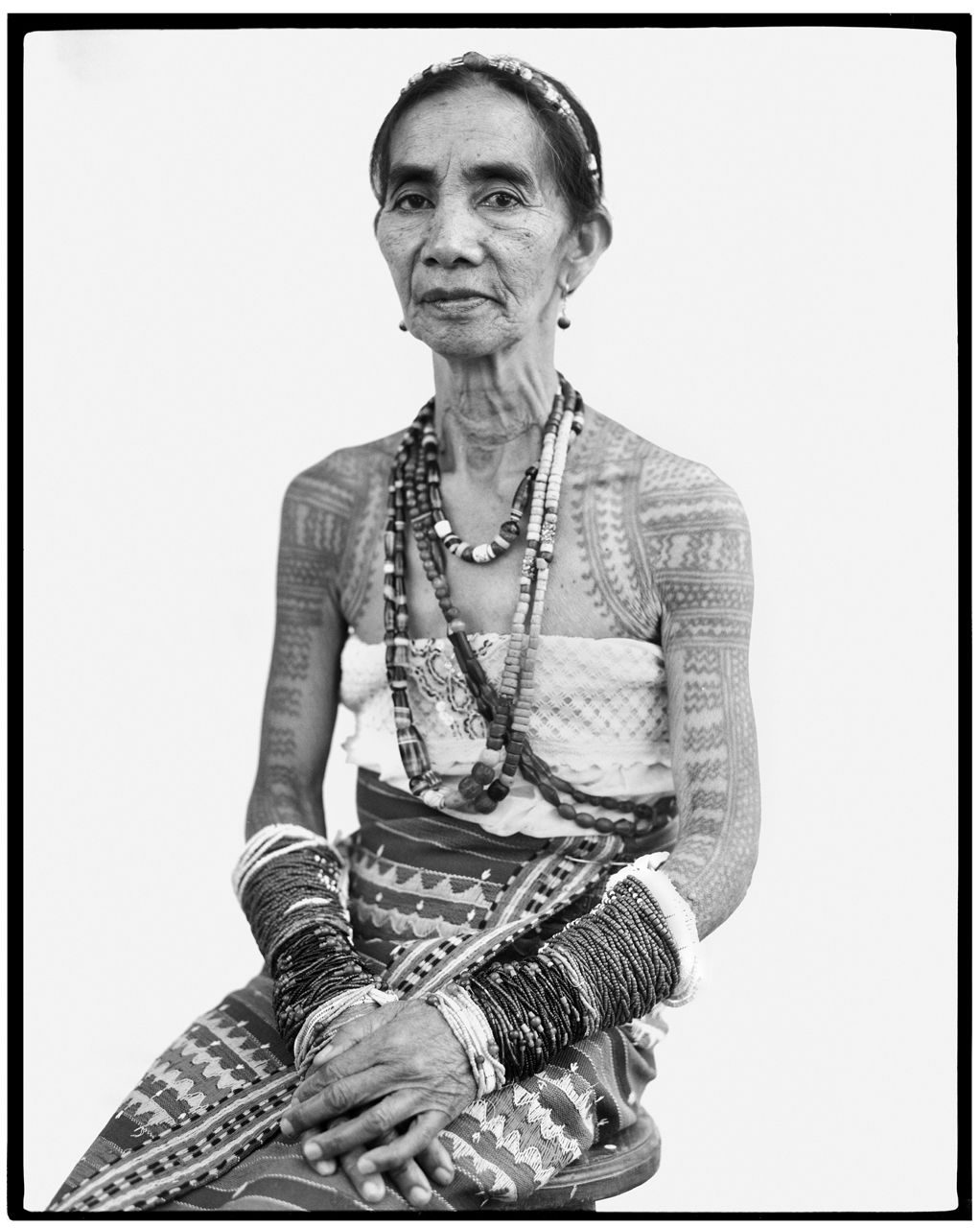
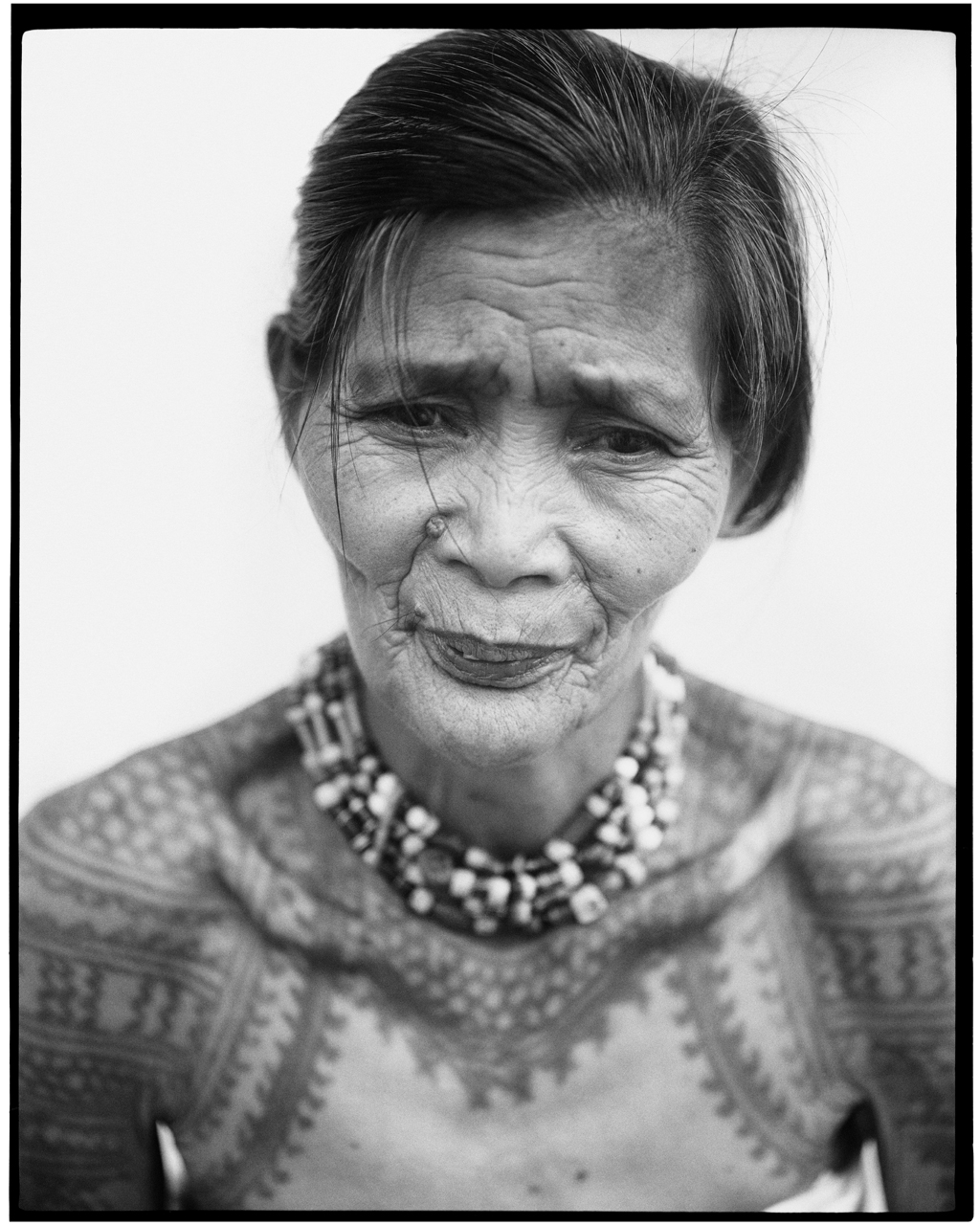
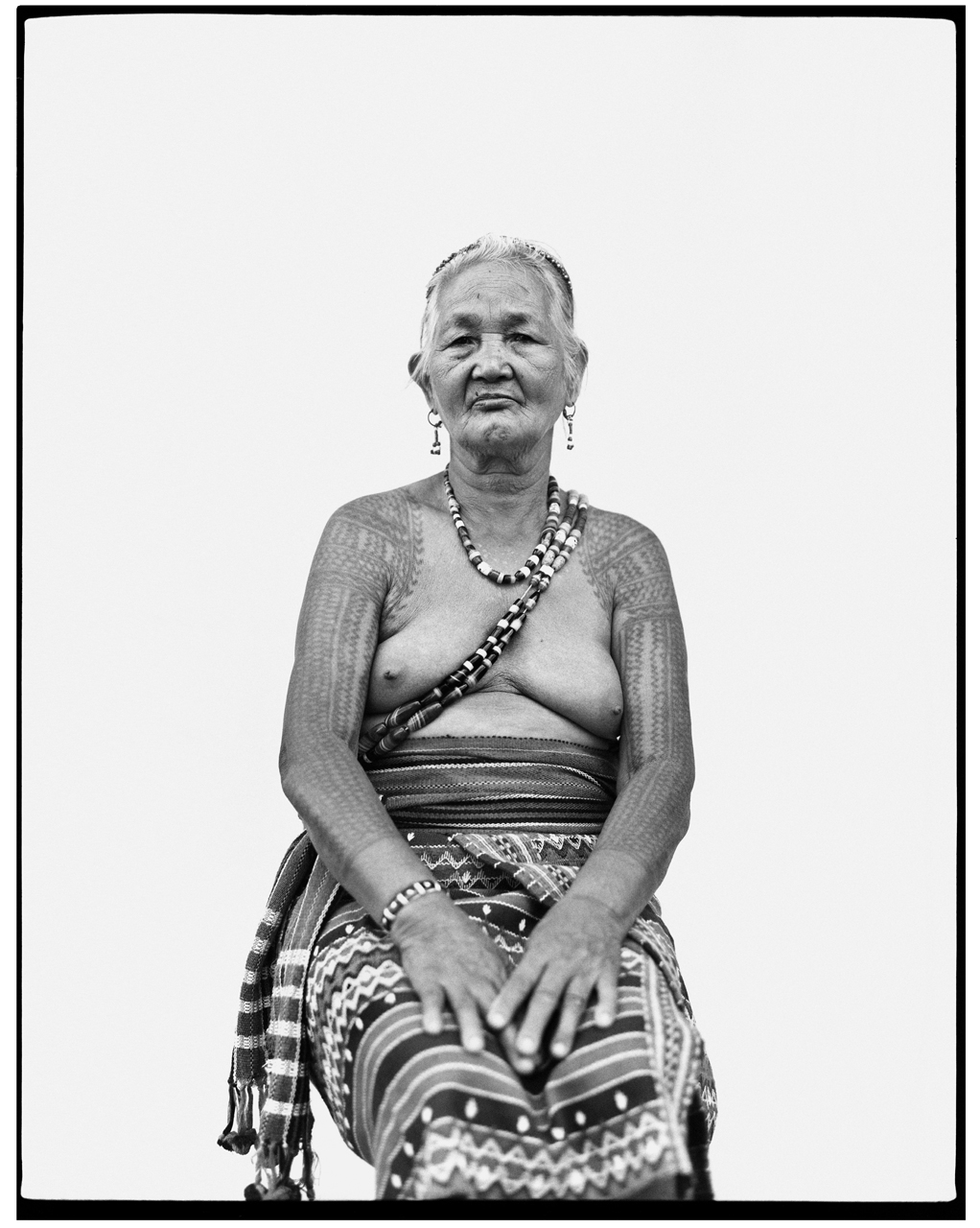
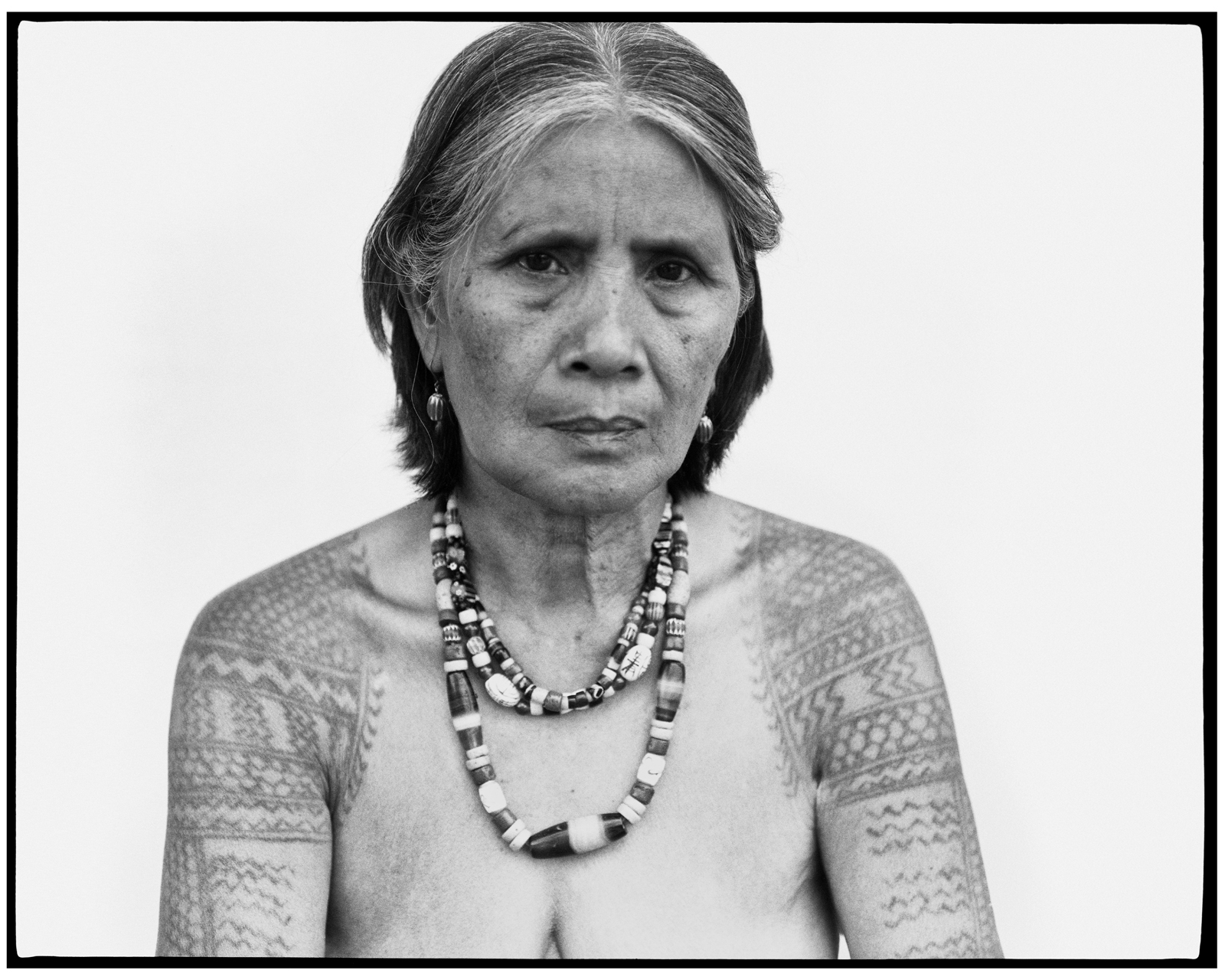
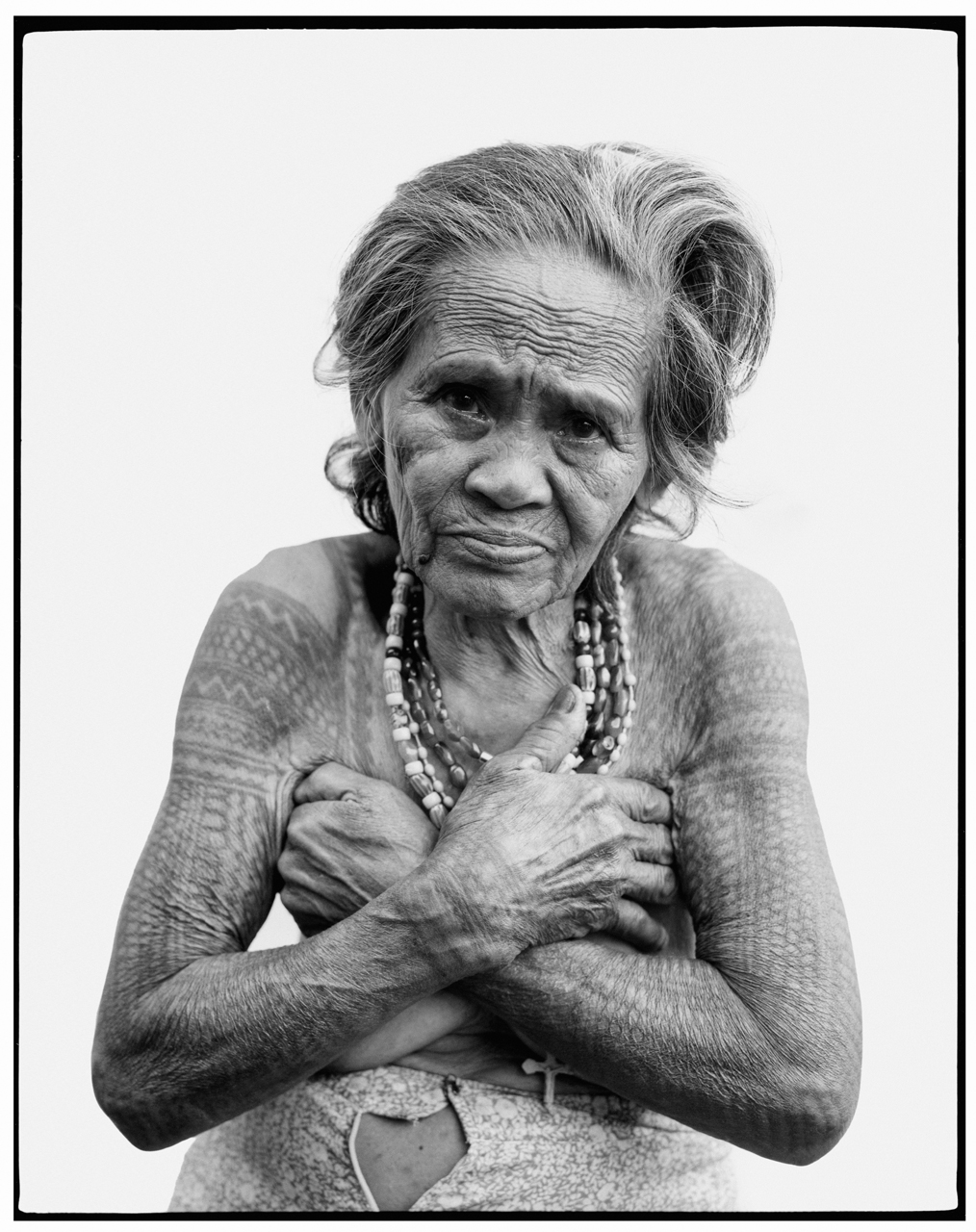
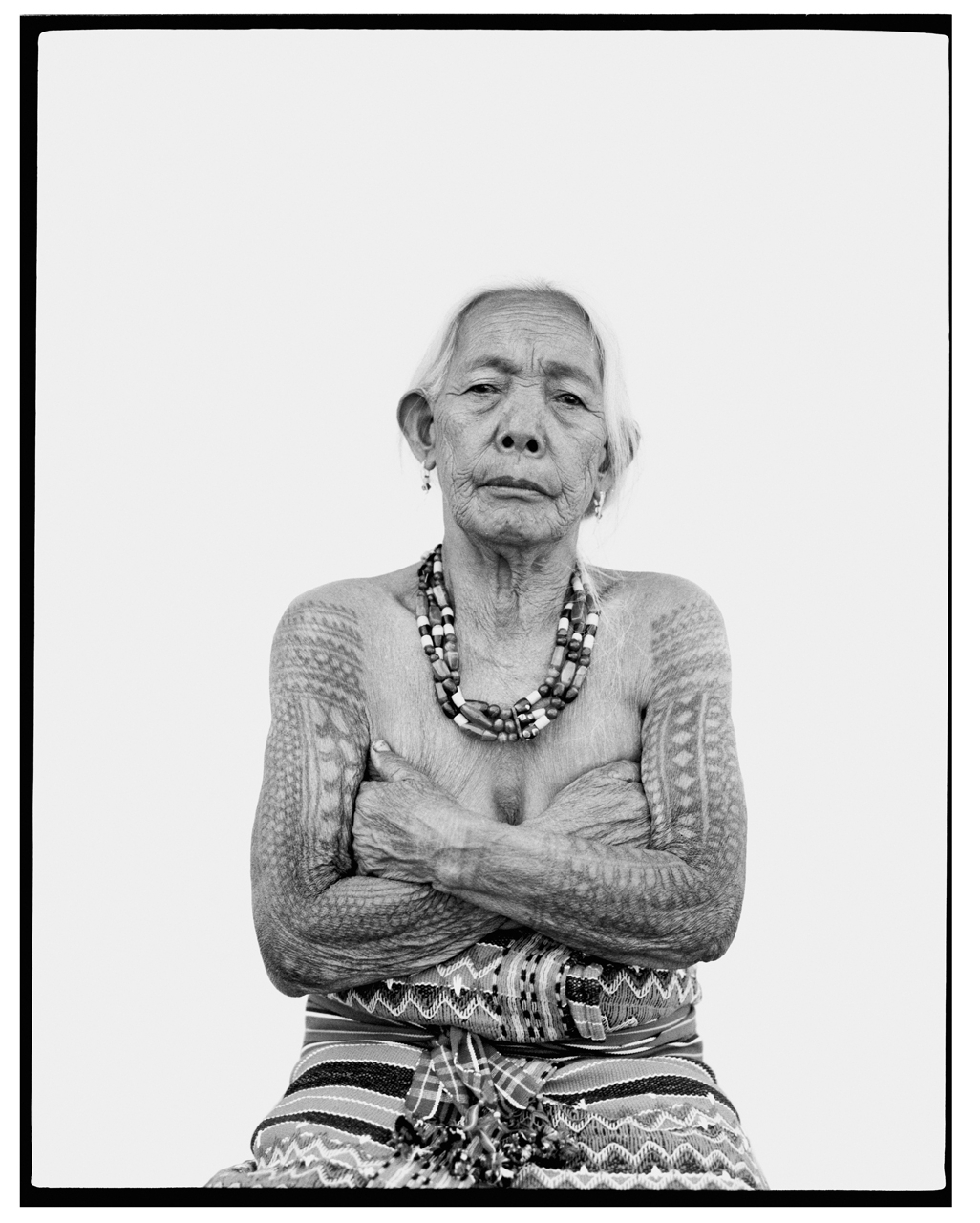
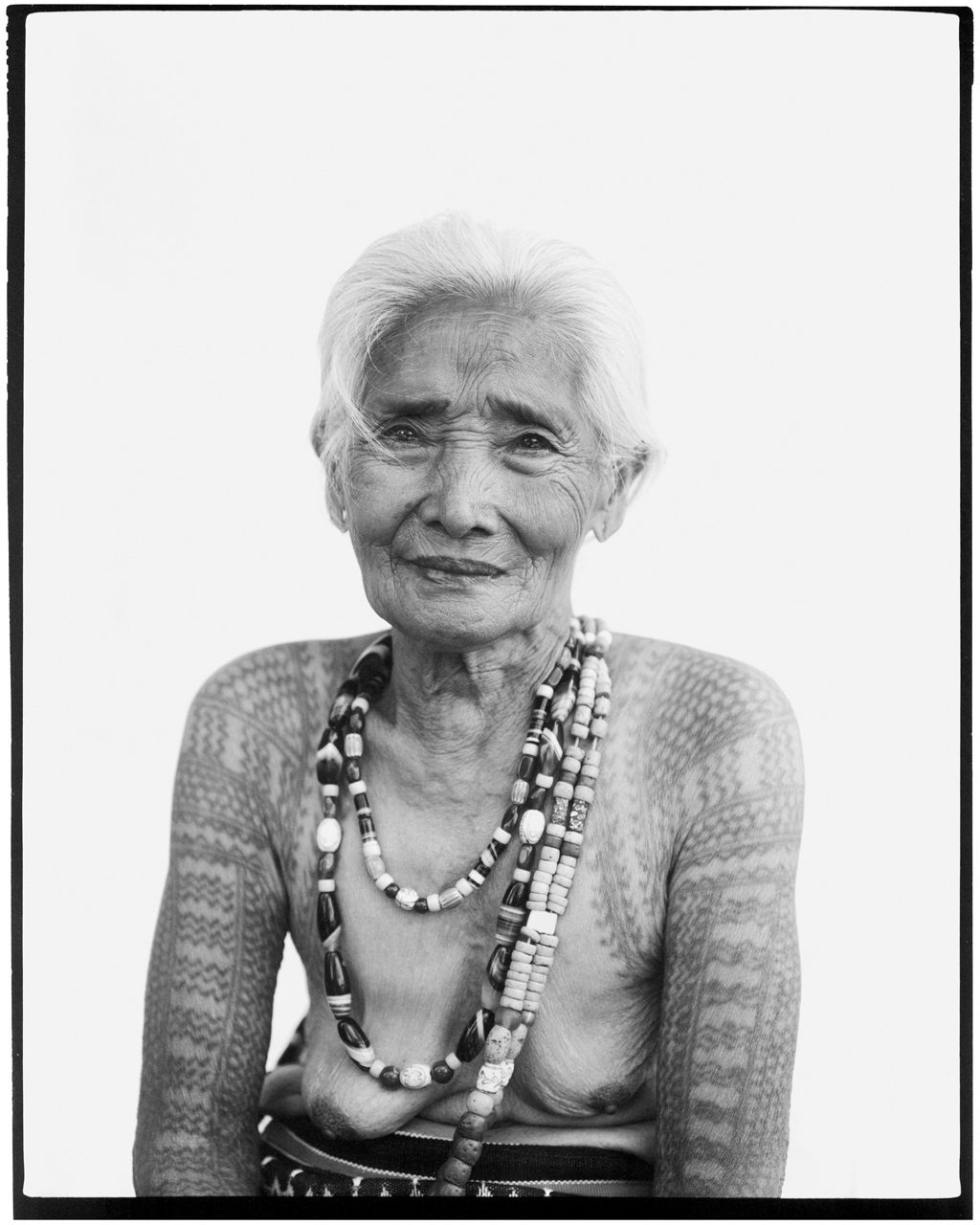
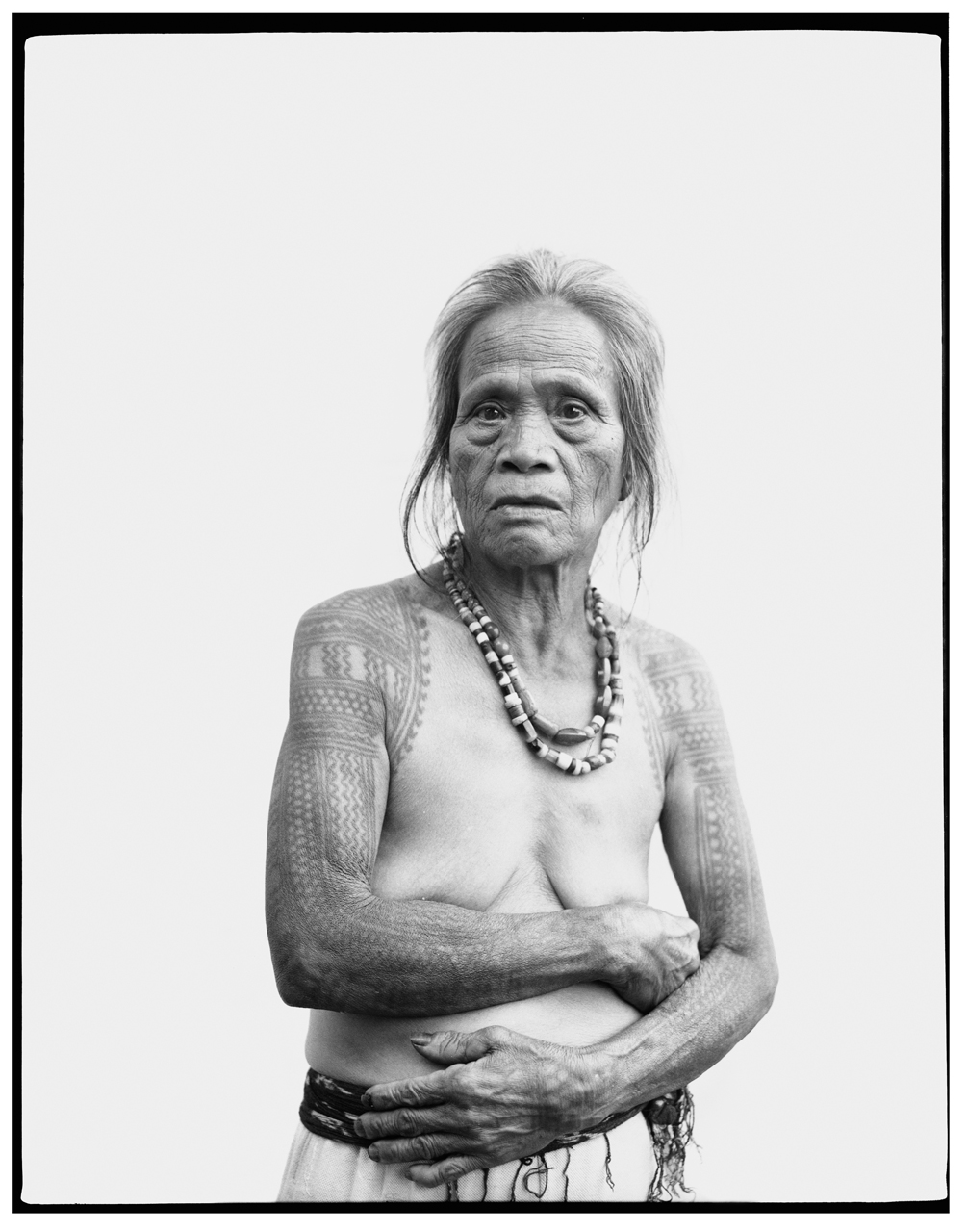
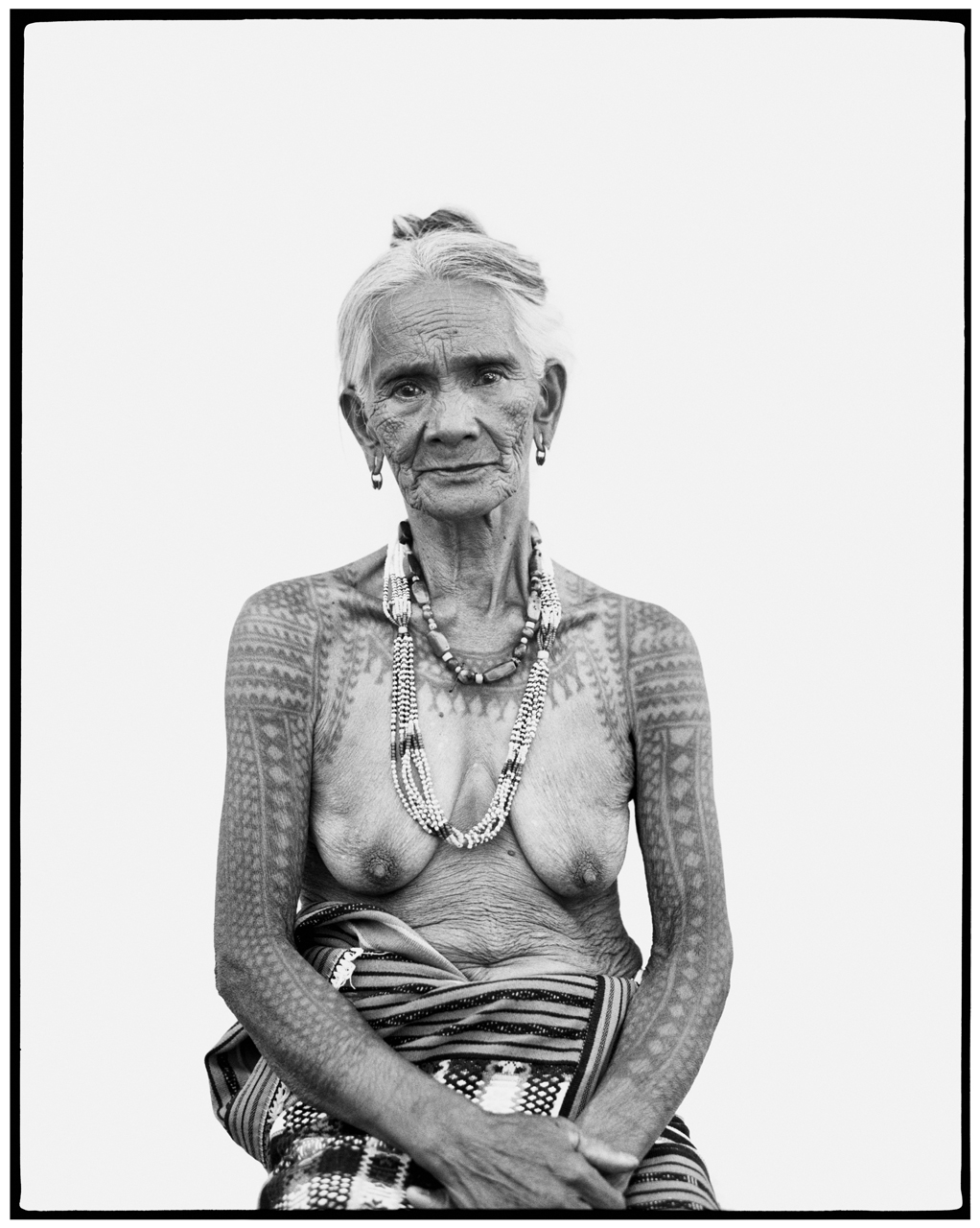
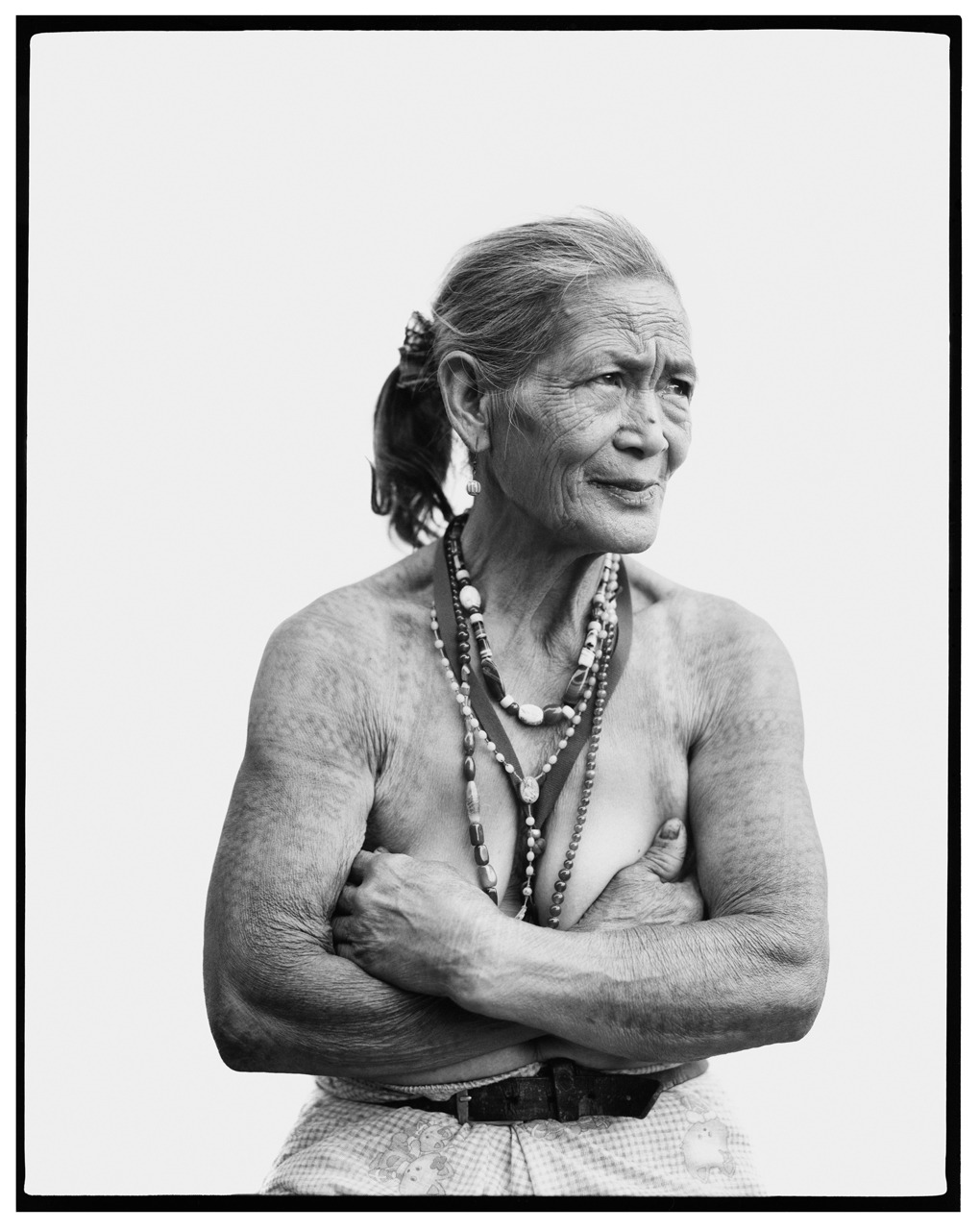
Available with full set
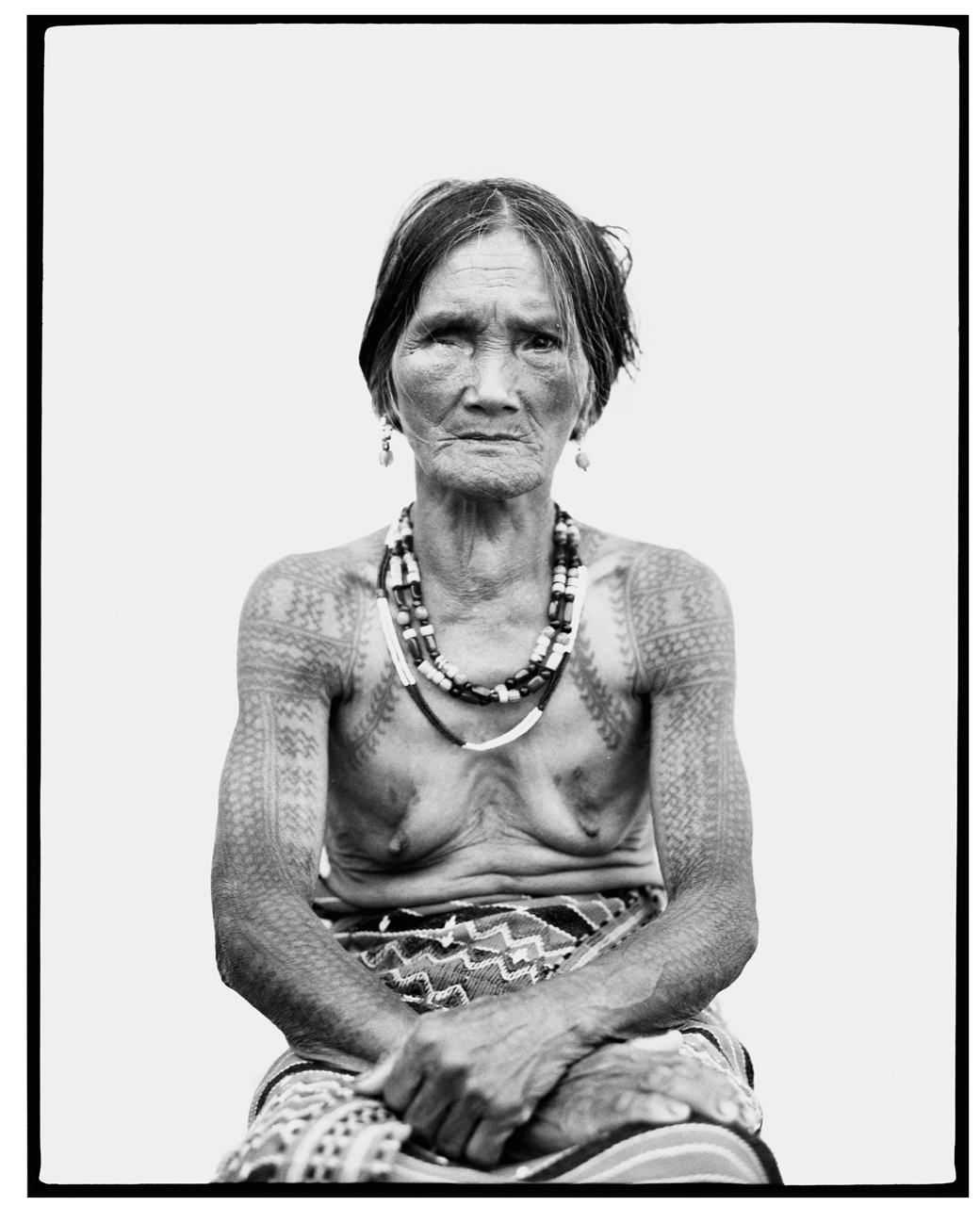
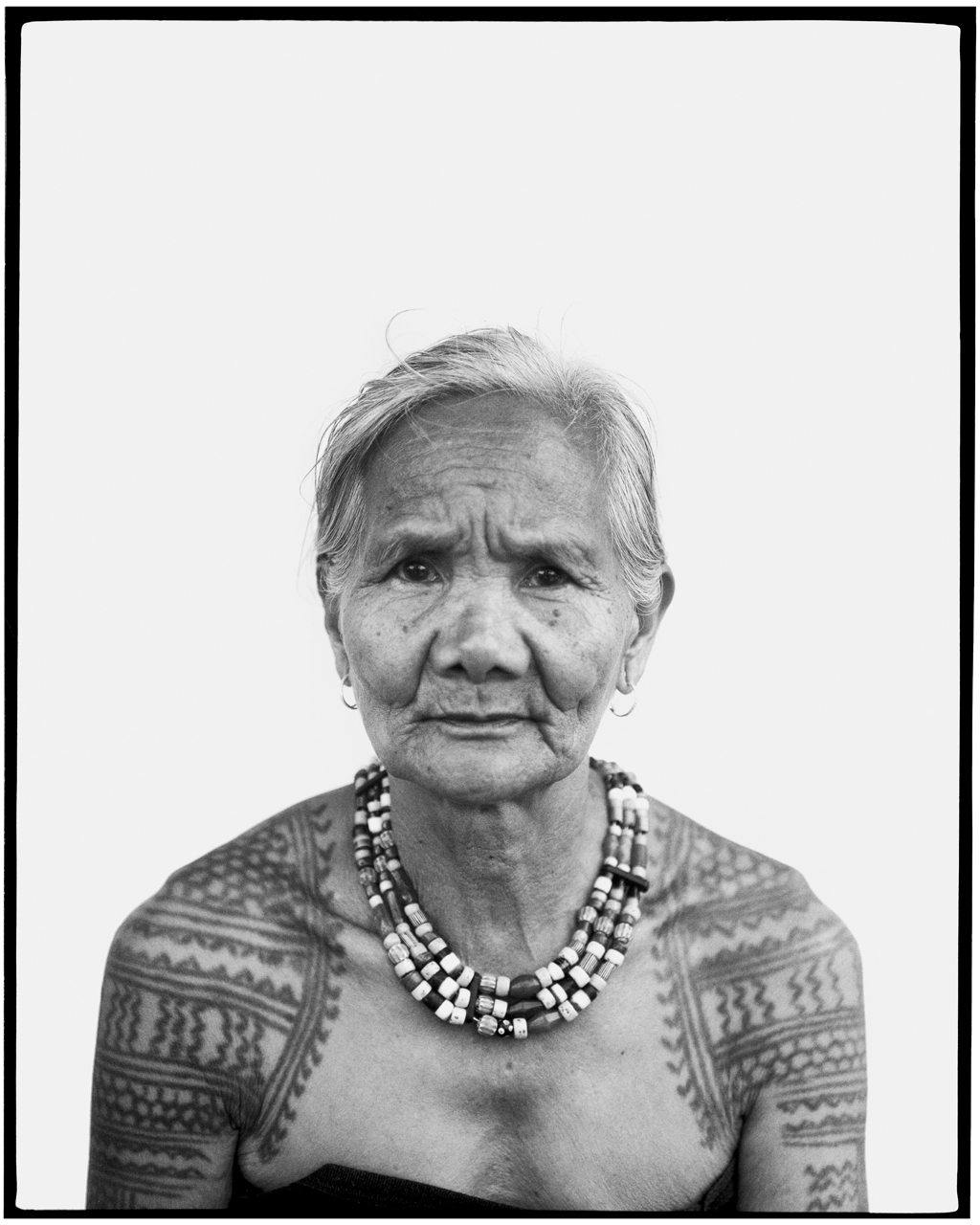
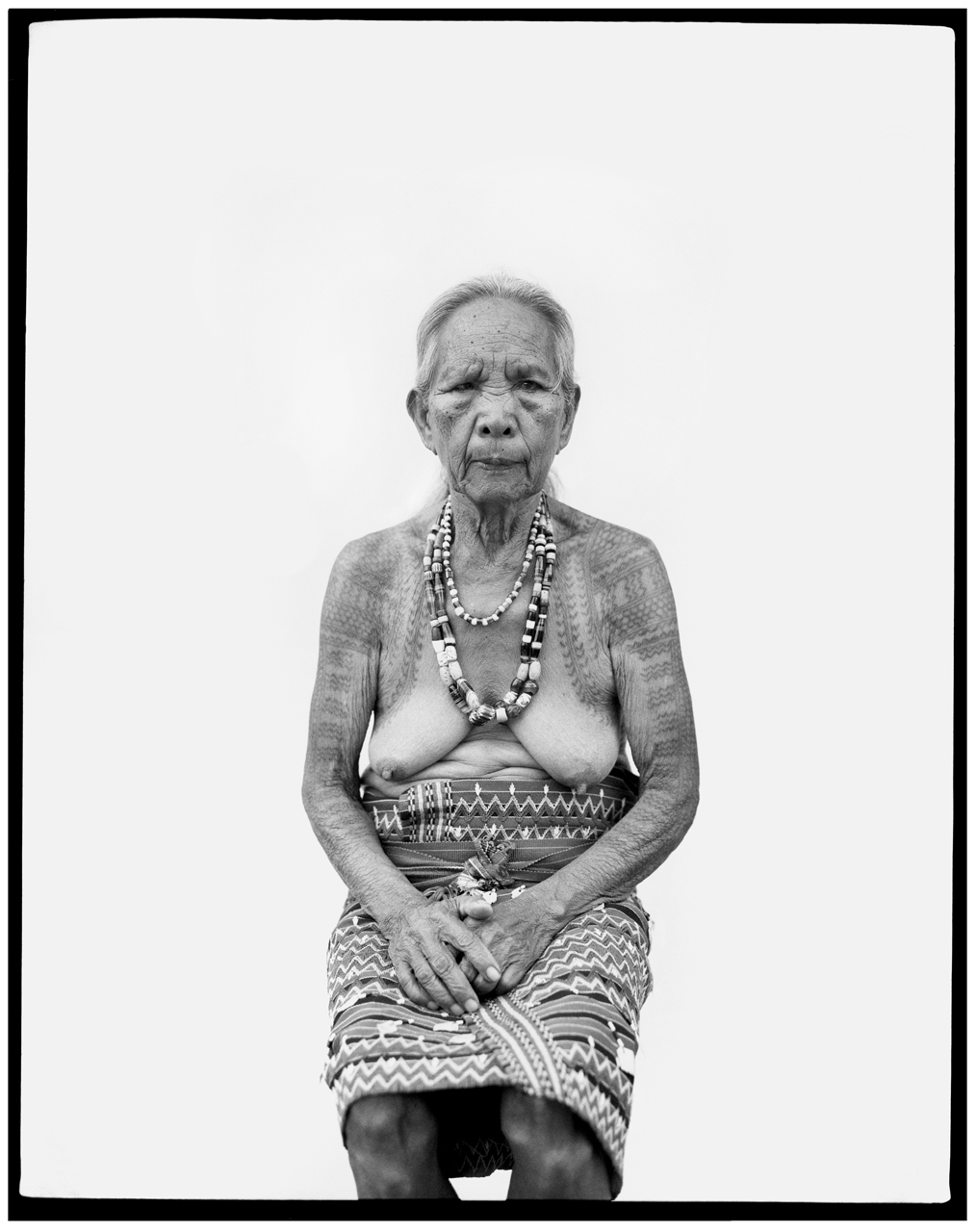
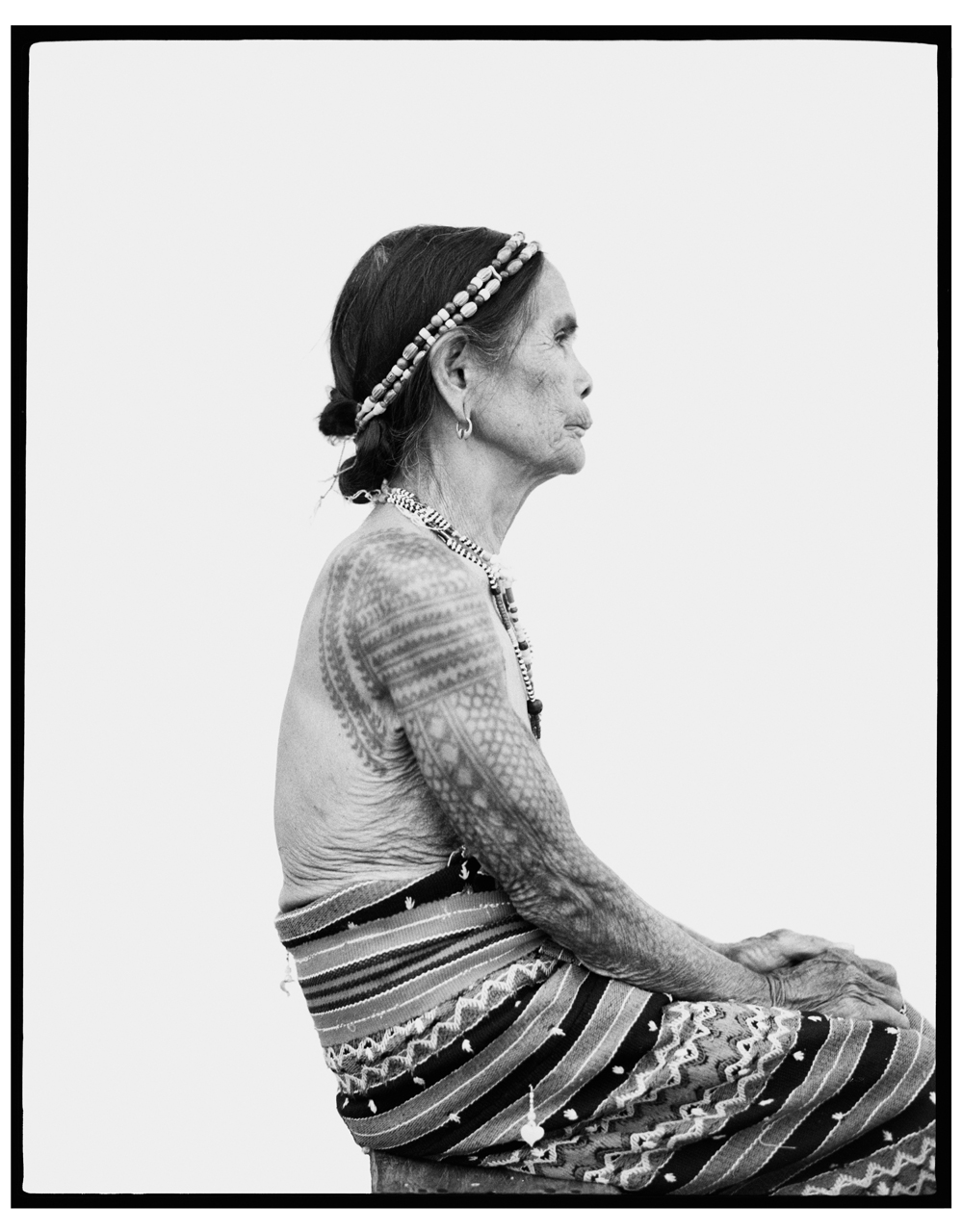
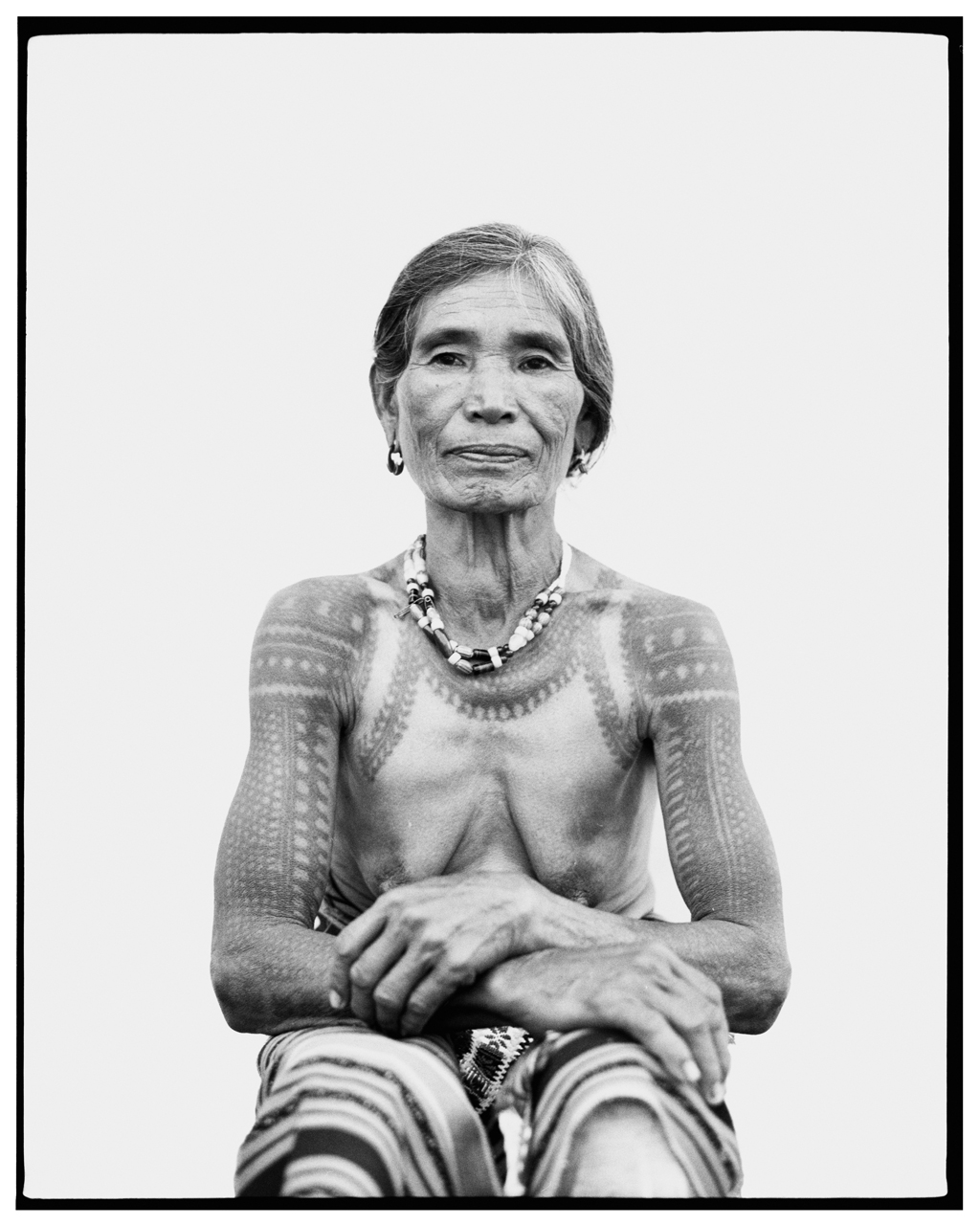
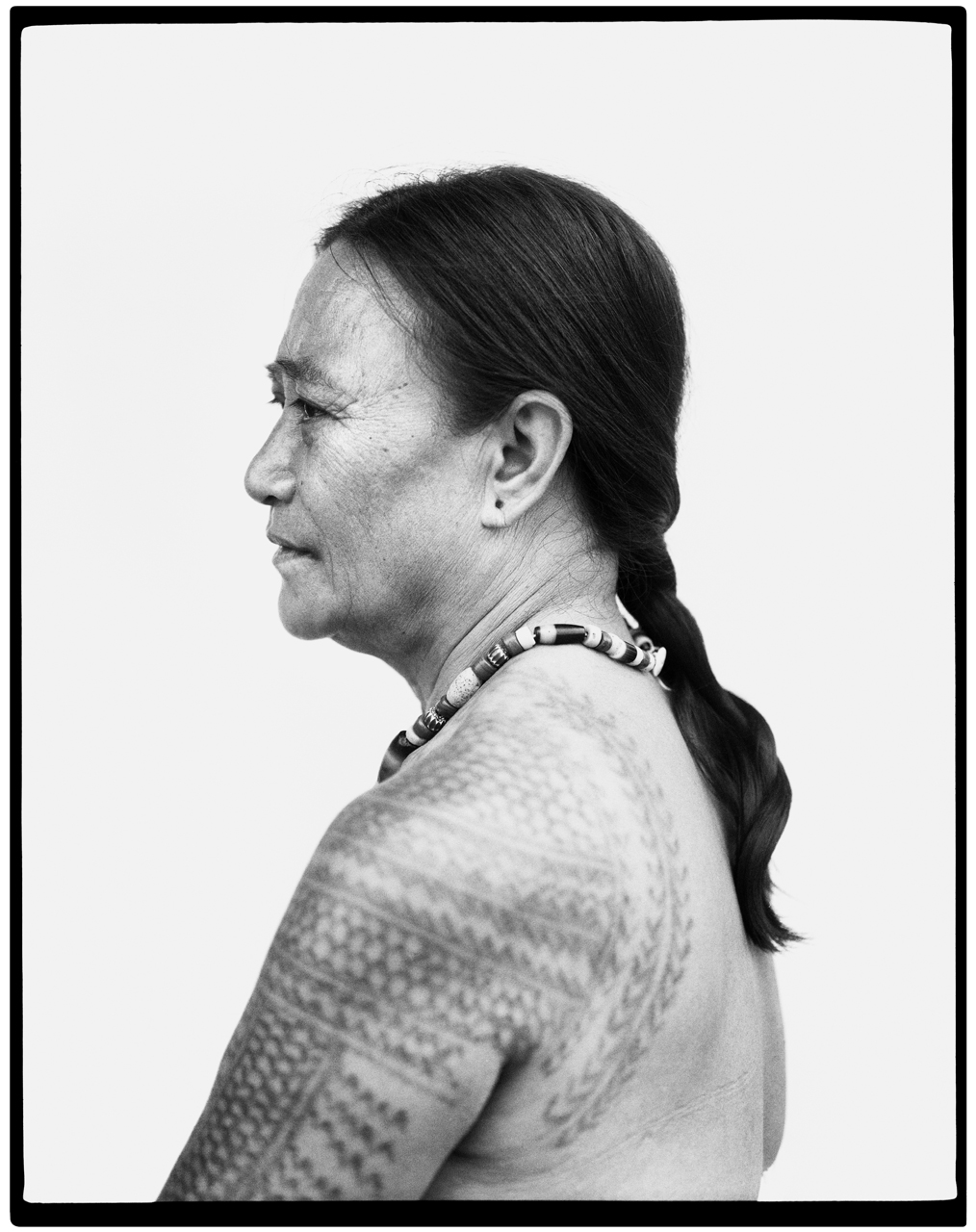
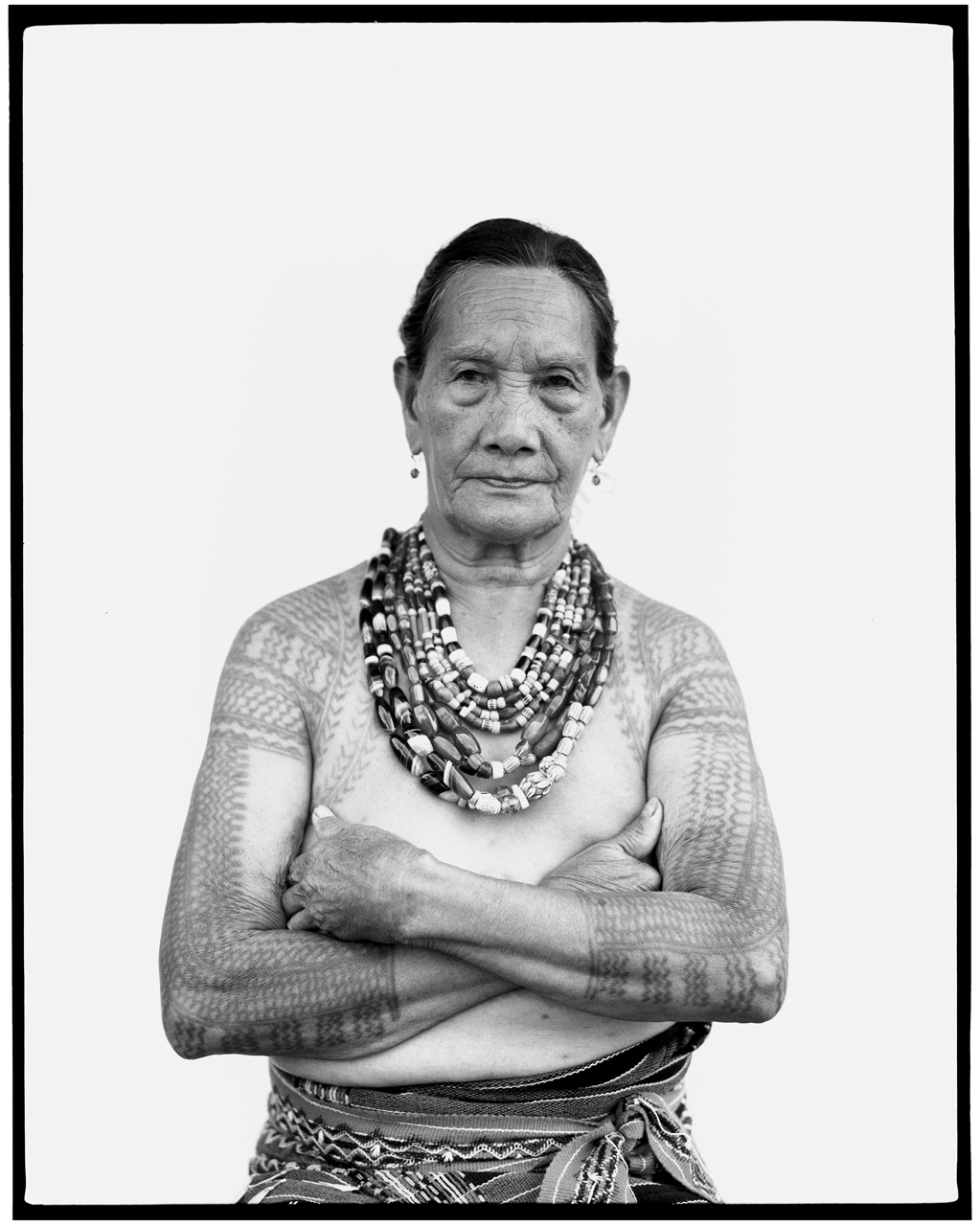
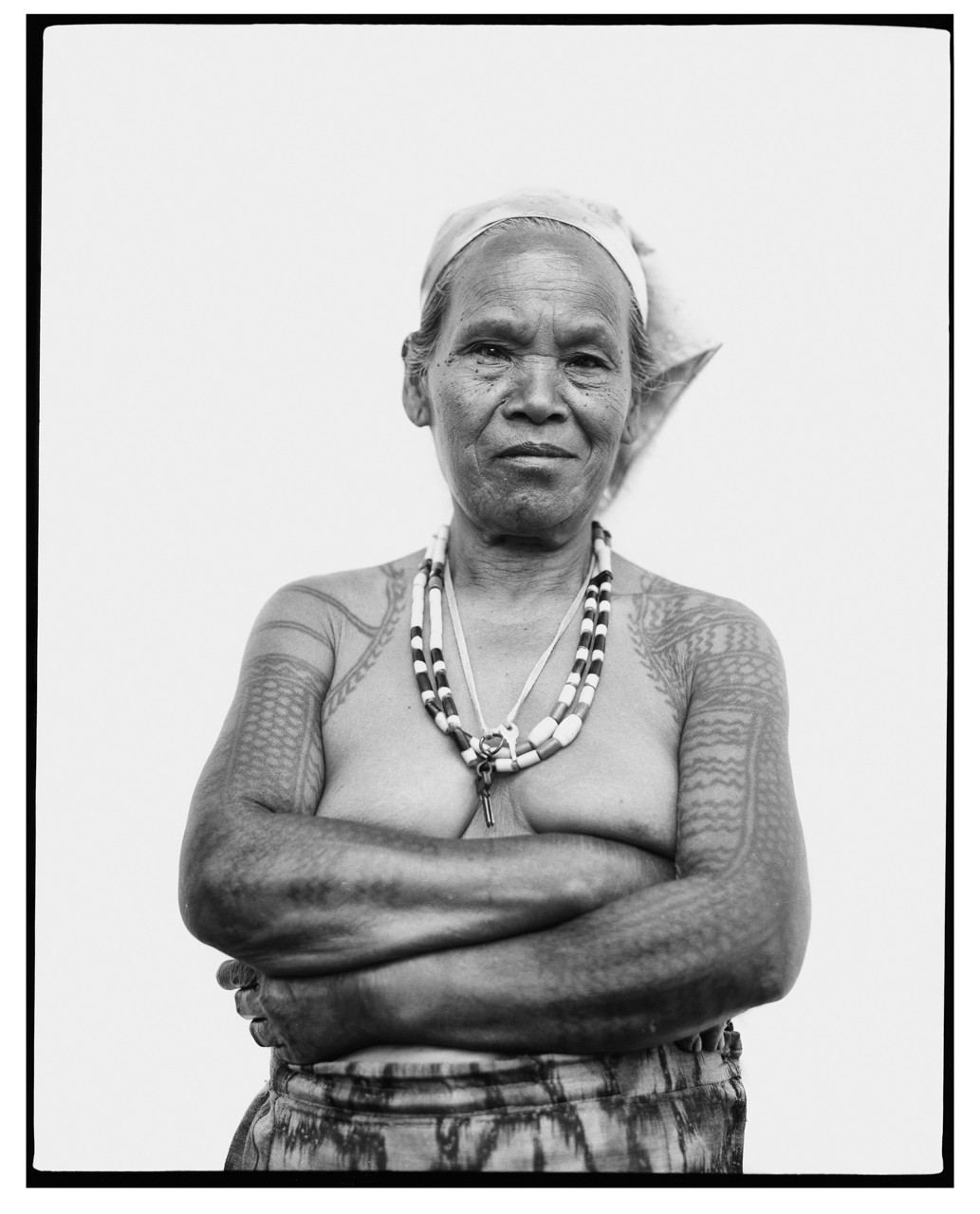
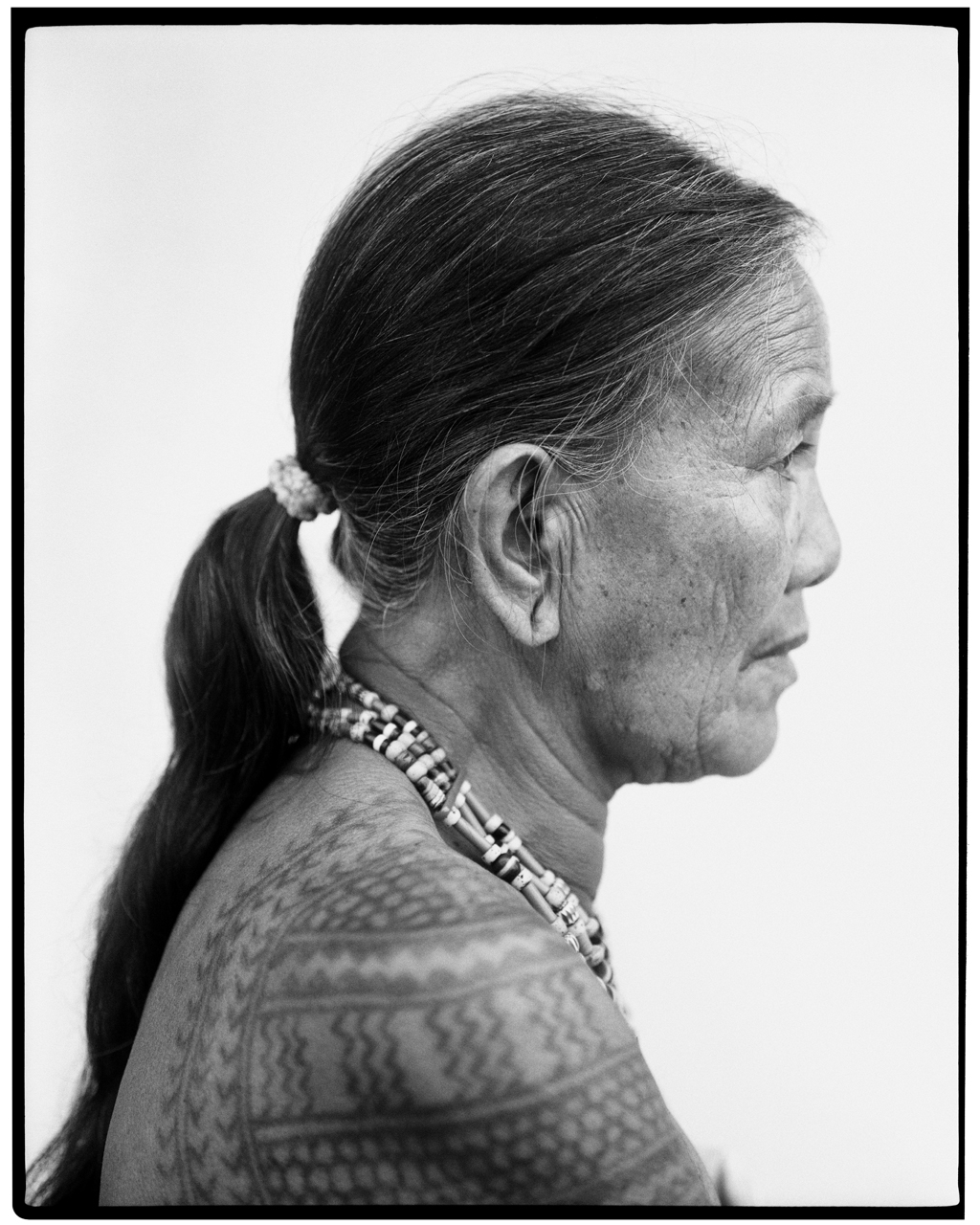
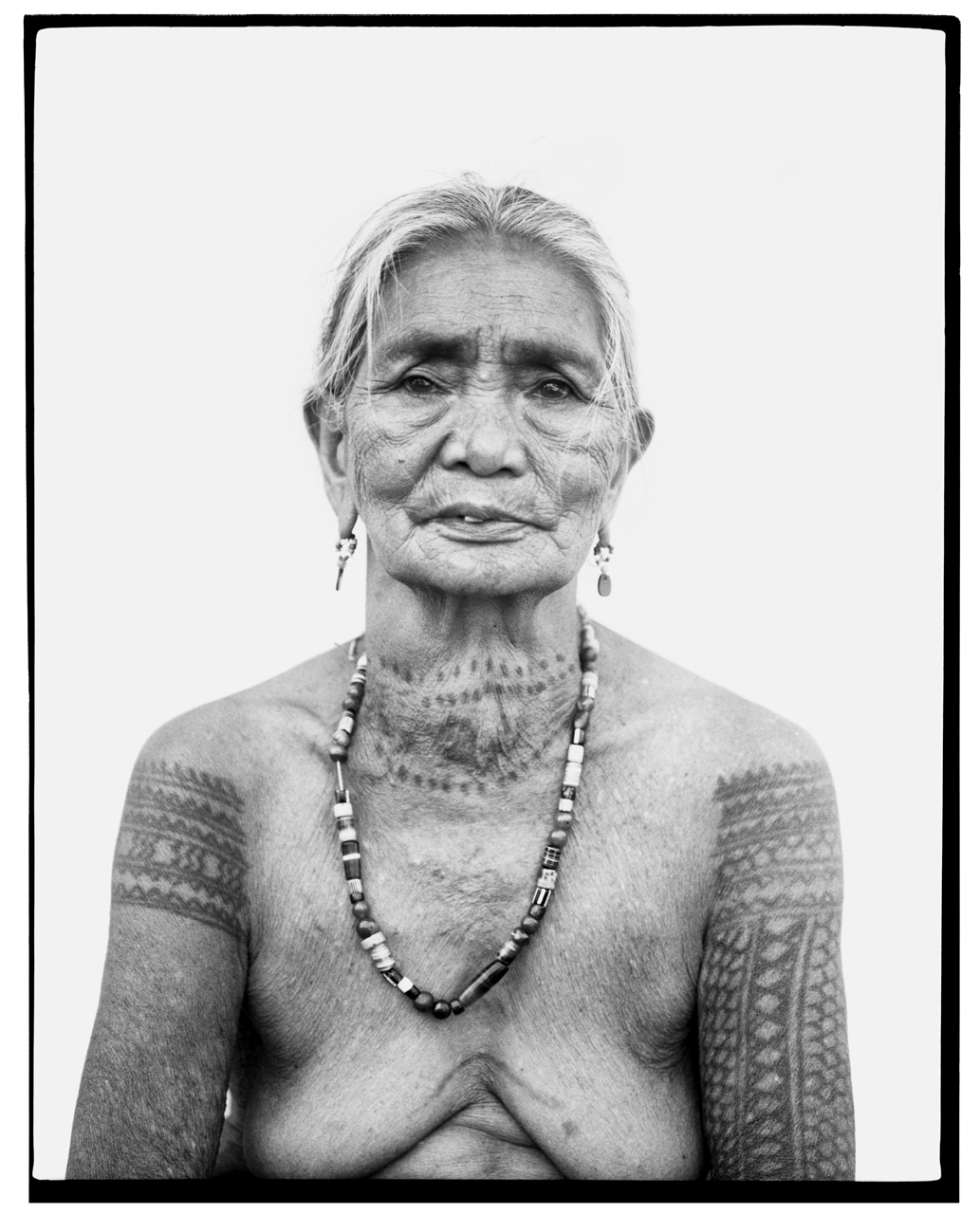
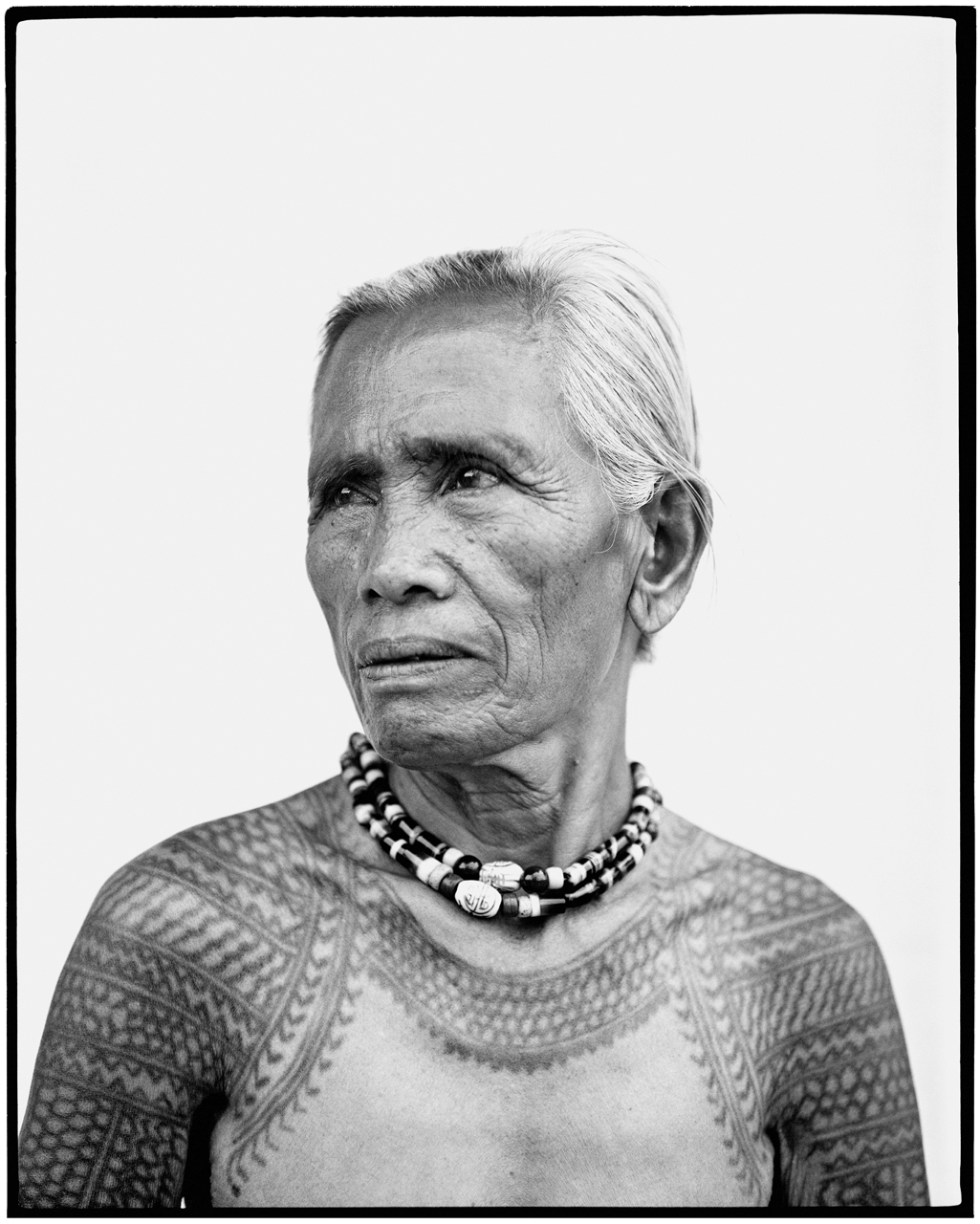
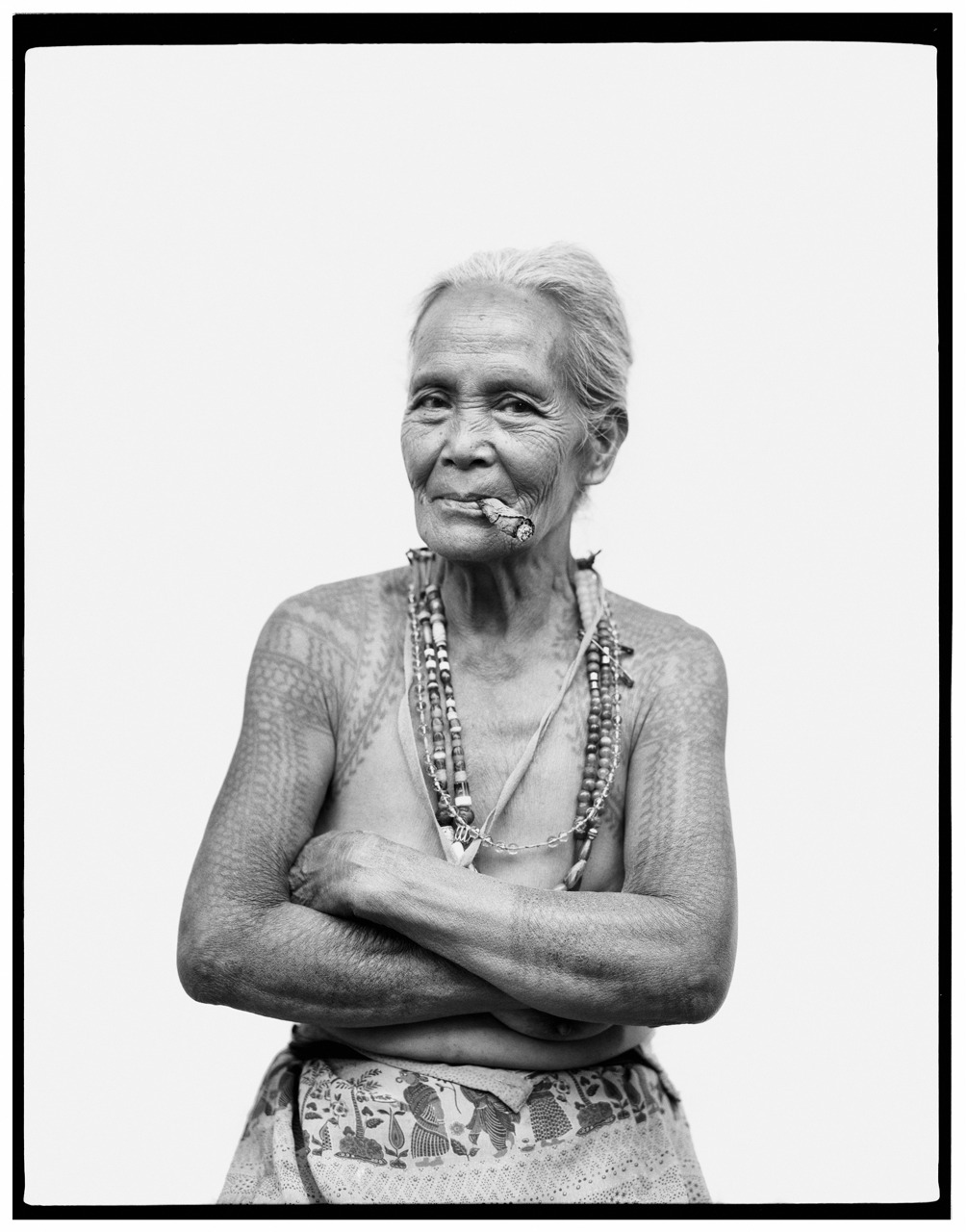
Available with full set
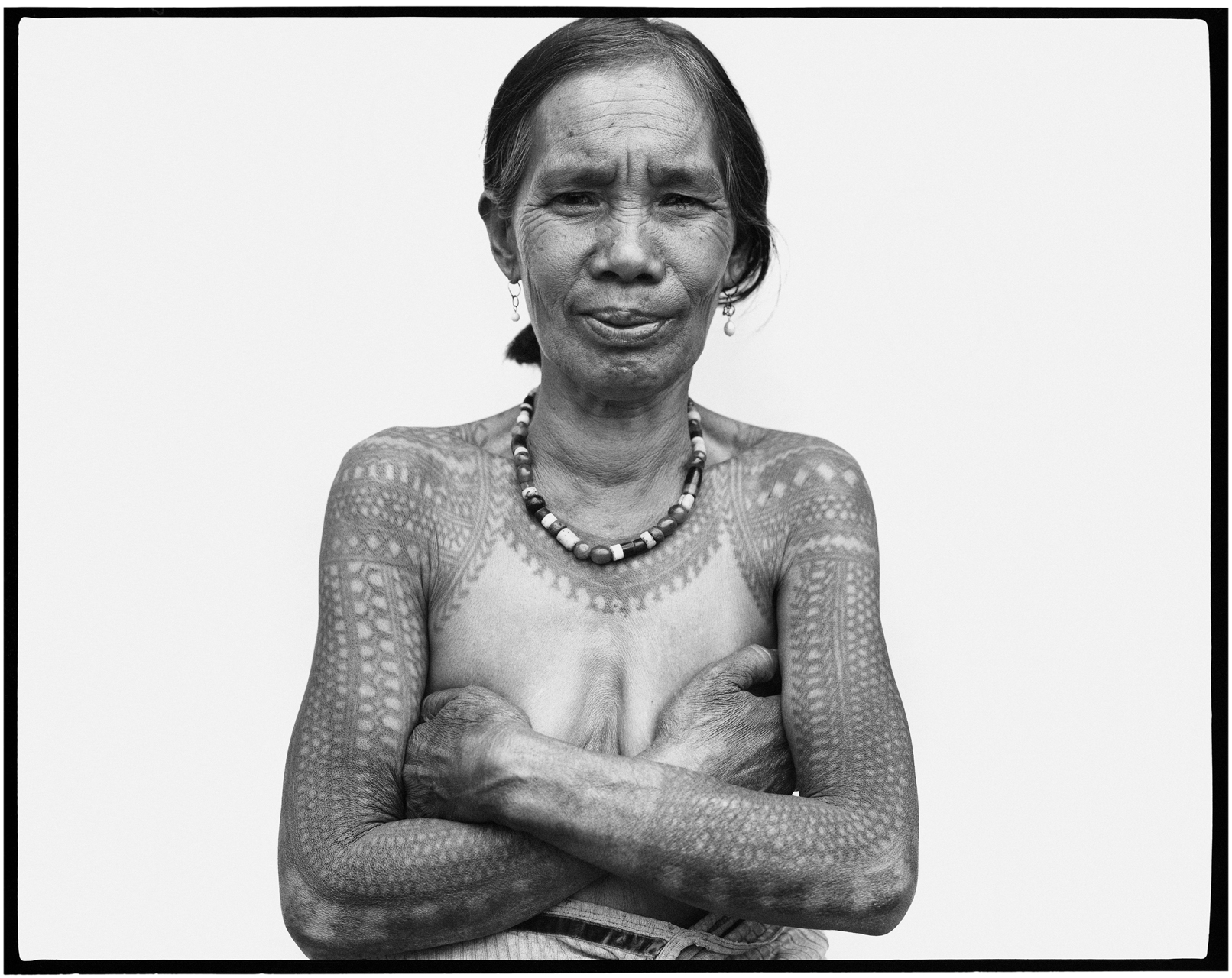
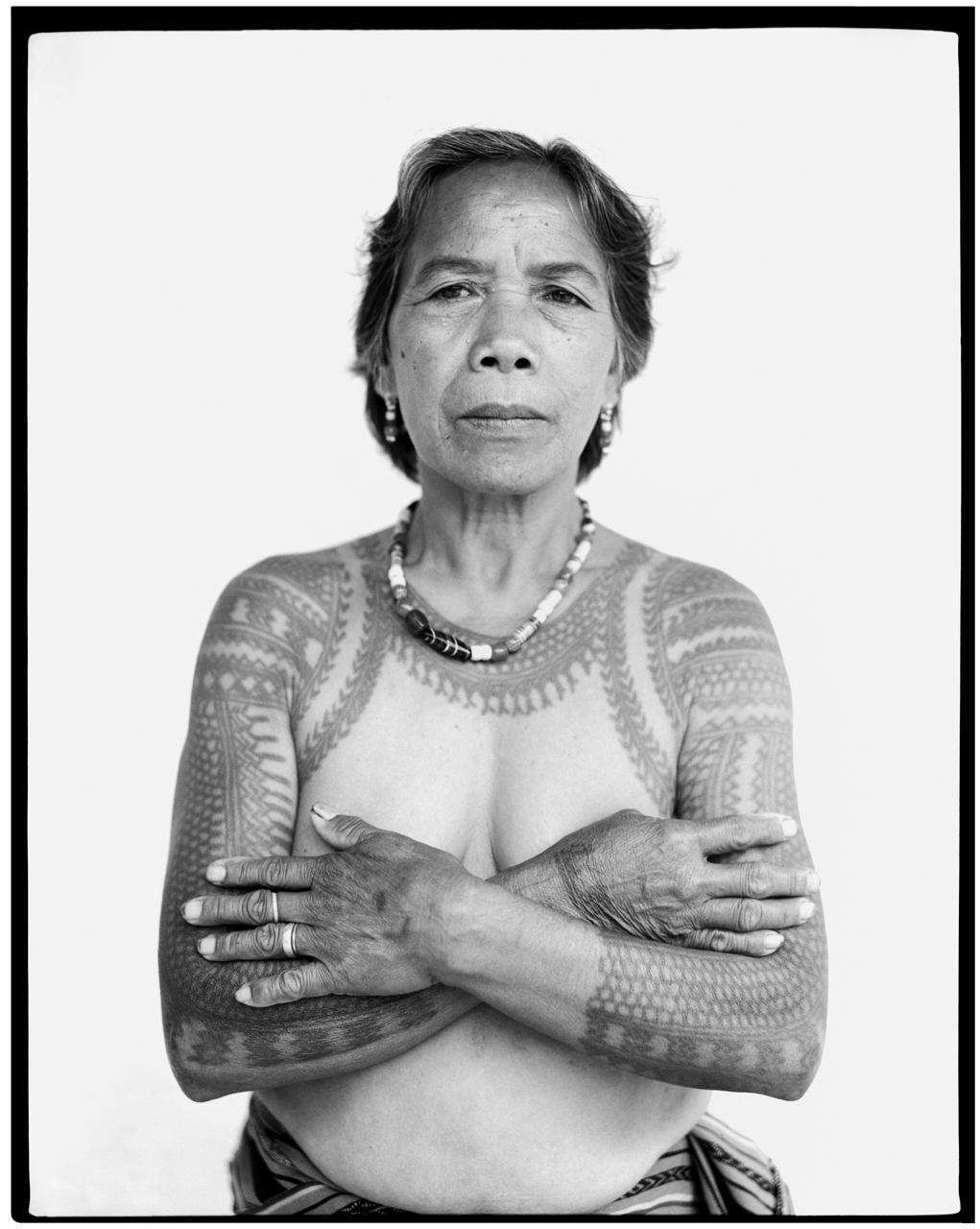
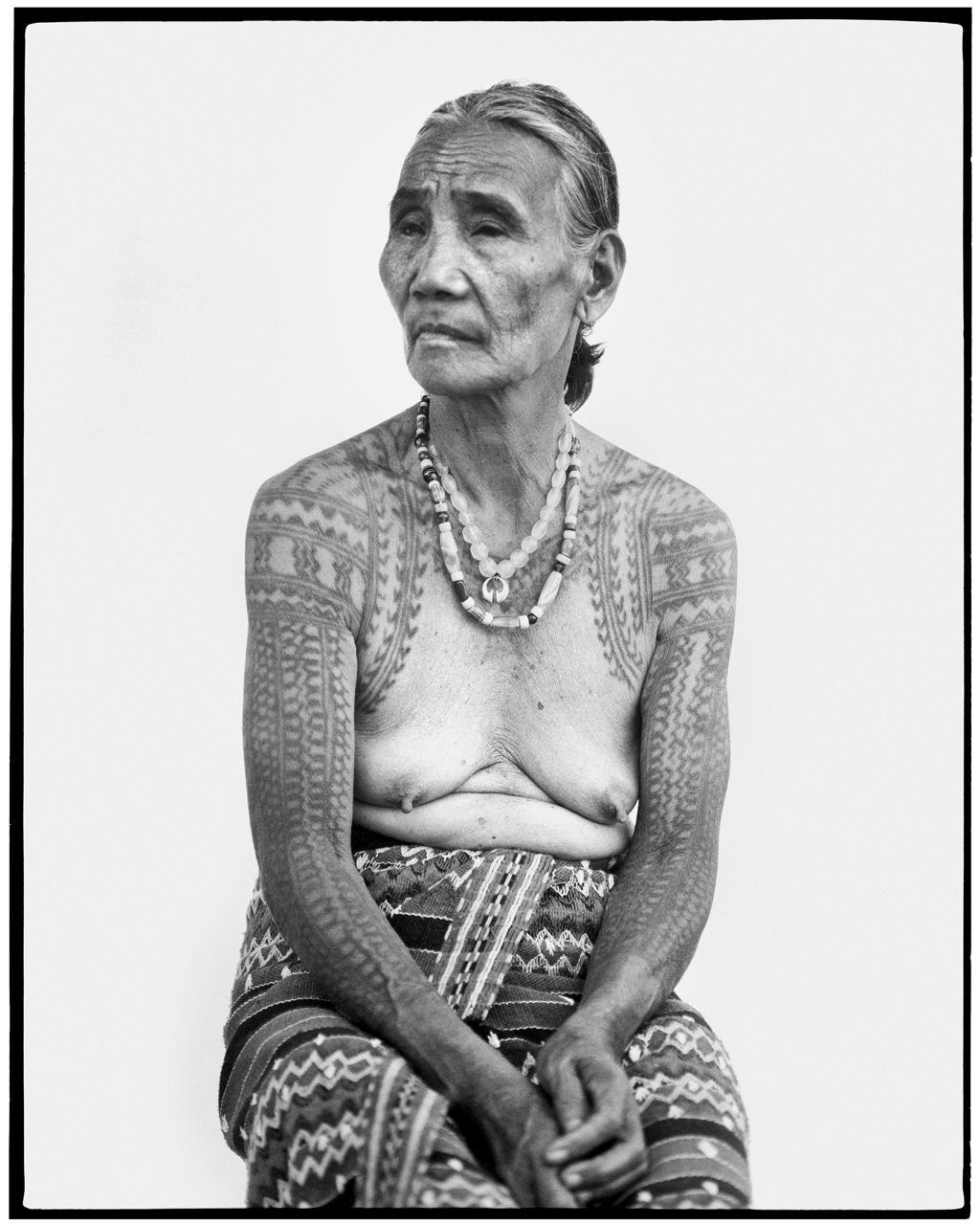
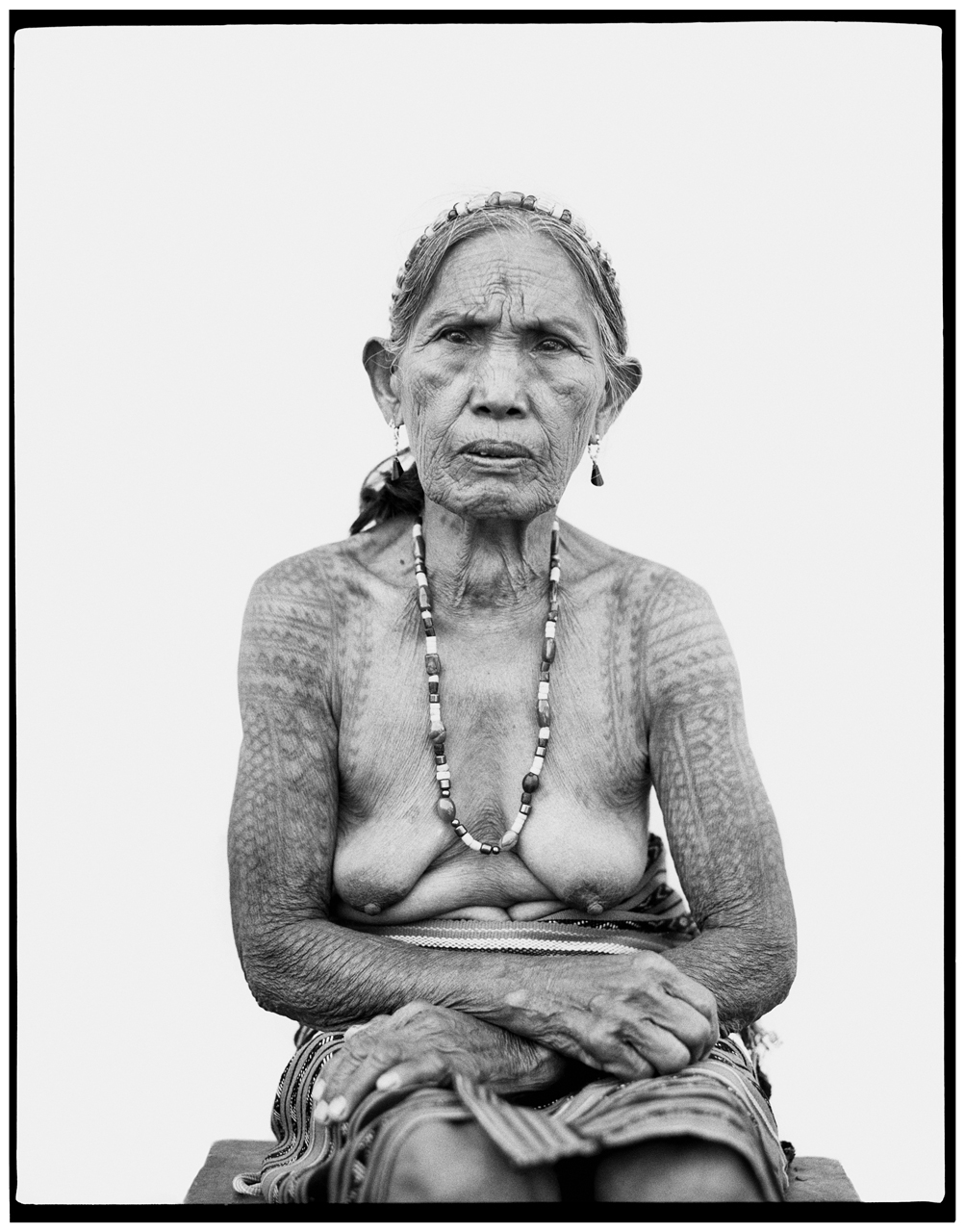
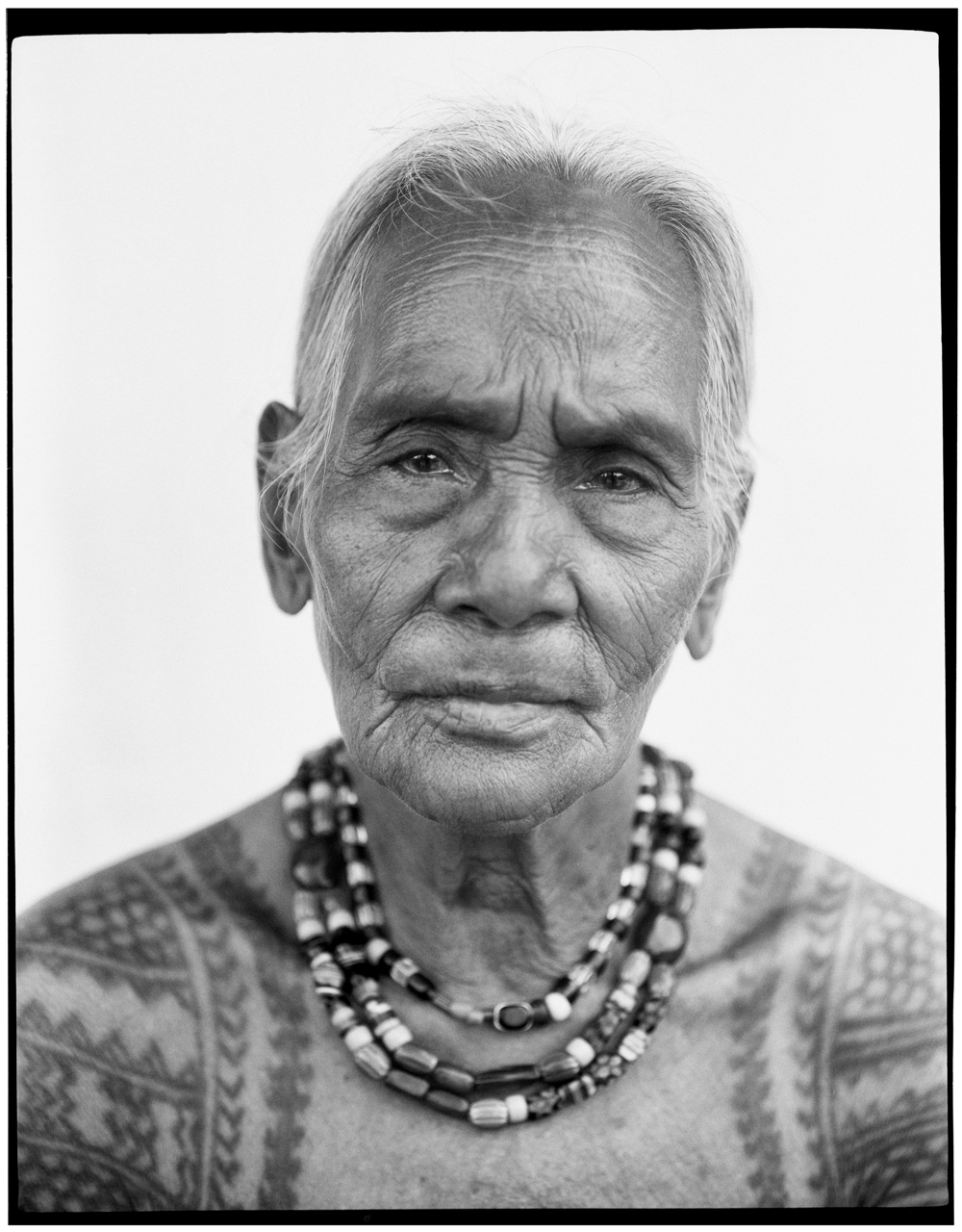
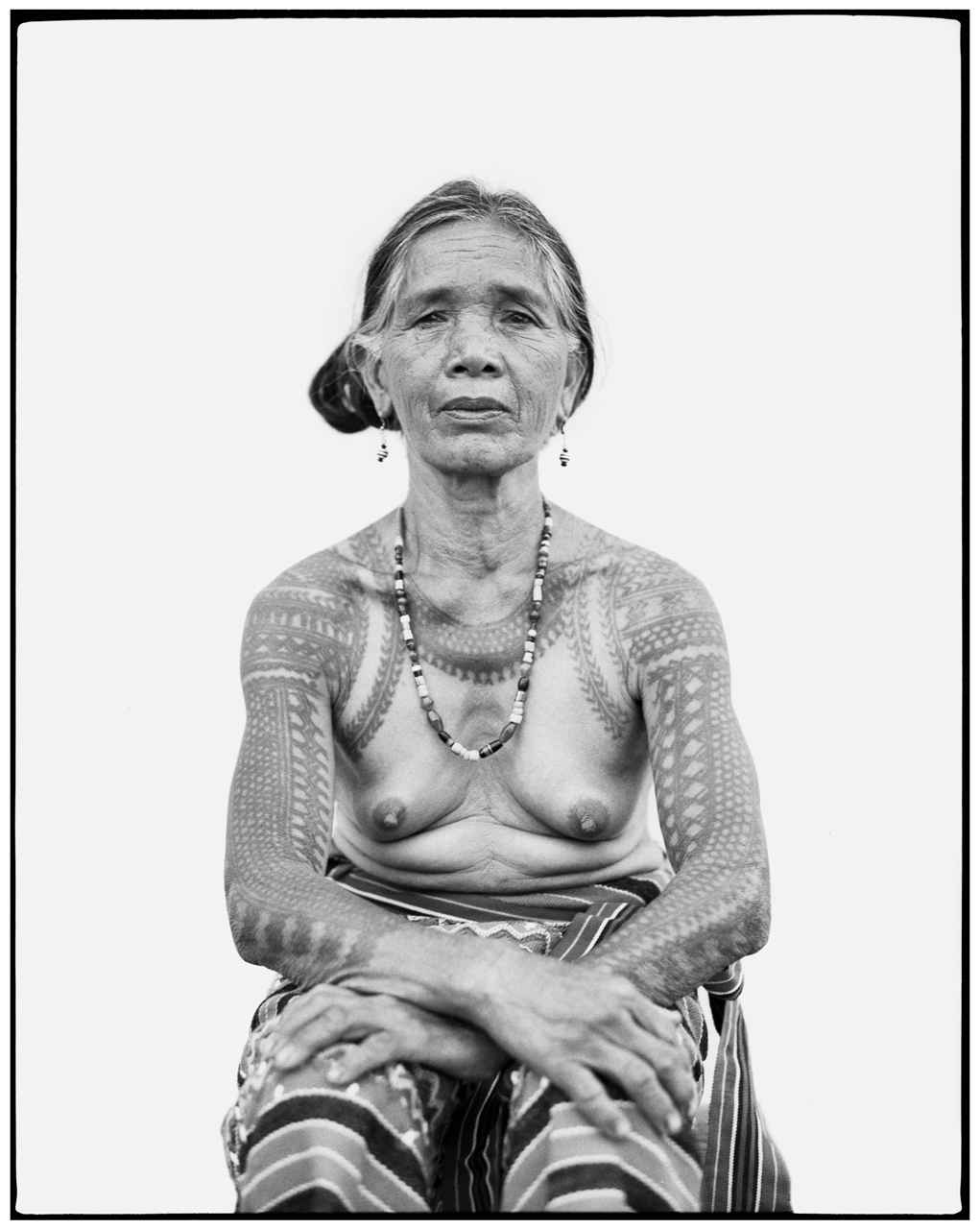
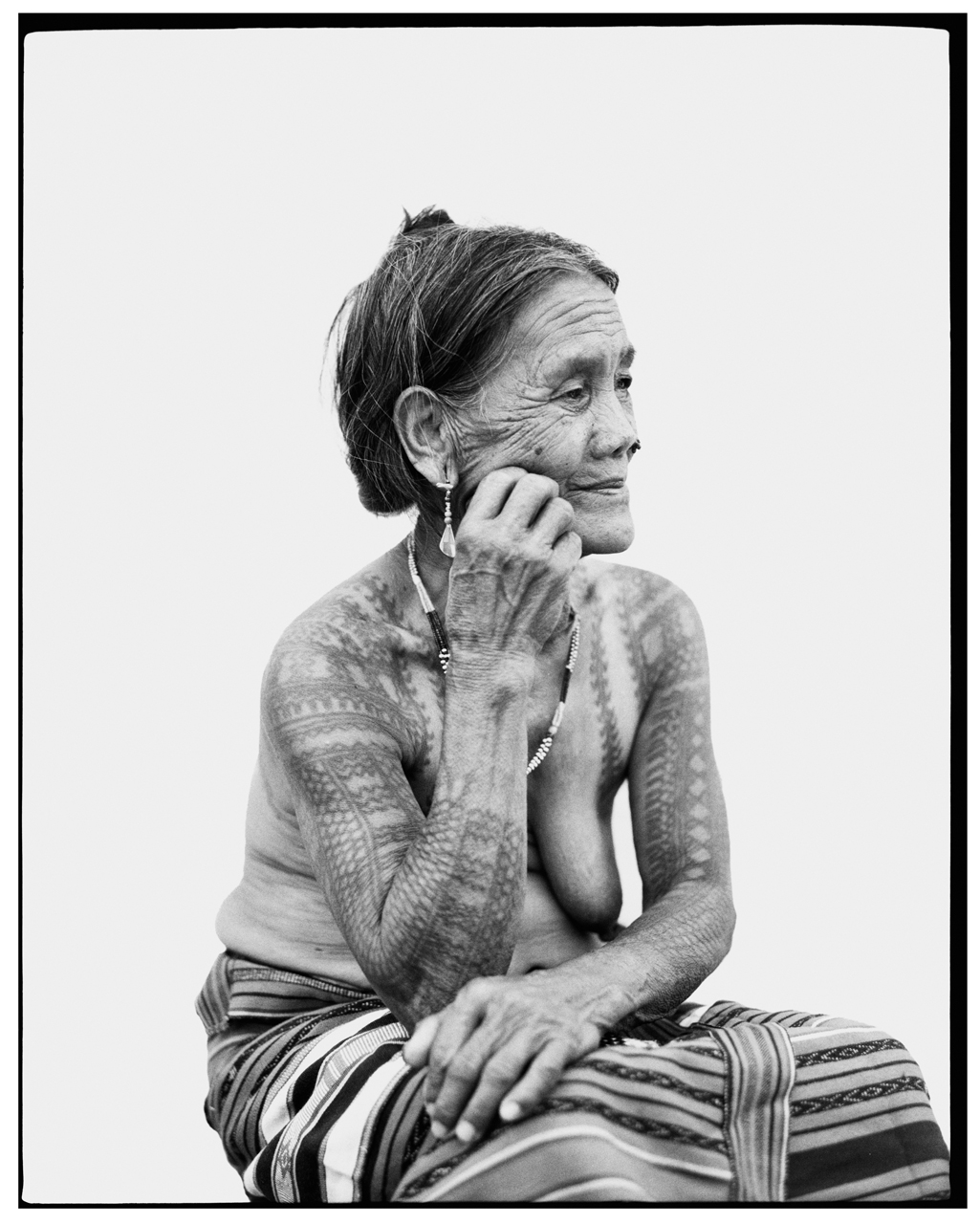
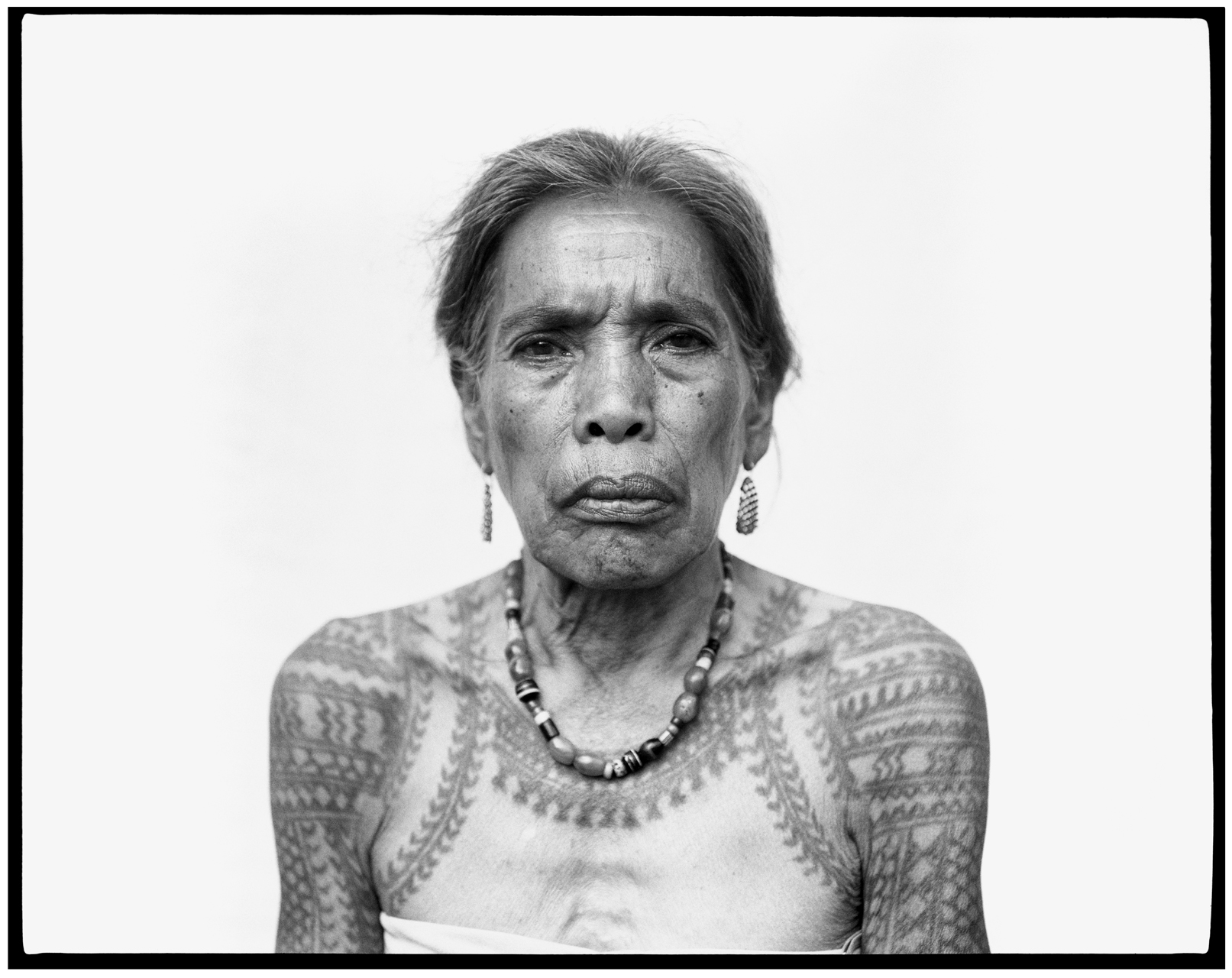
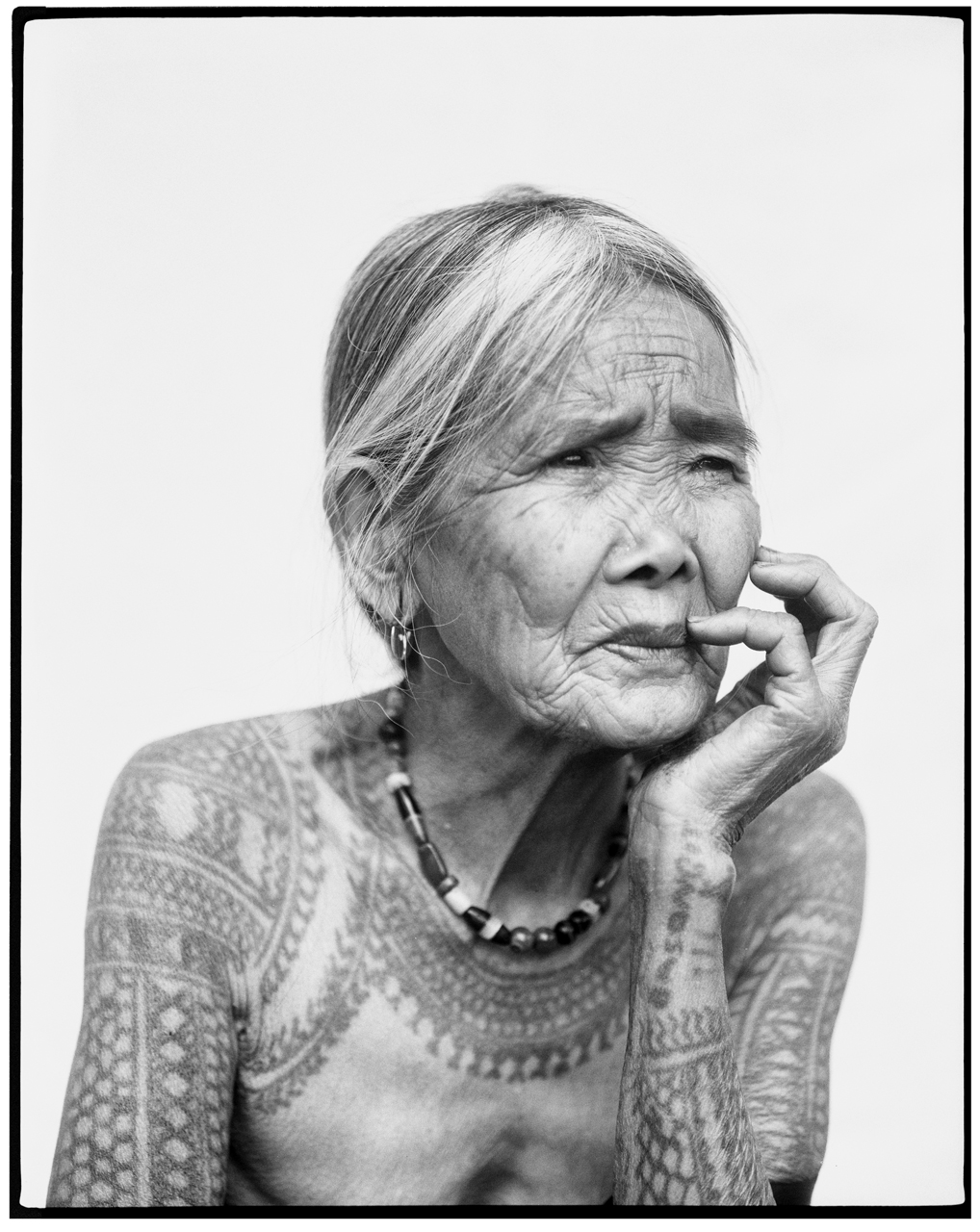
Available with full set
